Another Bouncing Ball: January 2010 Archives
 Karla Lieberman liked to build tottering things, held together by the force of their personality. In ceramic and later in glass and ceramic, she made elephants as spirit catchers, boats to cross troubled waters and towers to take you higher.
Karla Lieberman liked to build tottering things, held together by the force of their personality. In ceramic and later in glass and ceramic, she made elephants as spirit catchers, boats to cross troubled waters and towers to take you higher.She died at home on Tuesday a year and a half after being diagnosed with ALS, better known as Lou Gehrig's disease. She was 57.
"She was gracious about her illness," said her sister, Joan Lieberman-Brill. "It was devastating to get the diagnosis because there is no cure and its progression is terrible, but she stayed true to who she was."
Lieberman-Brill remembers visiting her sister in her dorm room at Evergreen State College to find her reading Ram Dass. Like him, Lieberman became a spiritual person in the widest sense and completely free of dogma. "She wasn't judgmental, didn't care about acquiring material things and gave everybody the benefit of the doubt," said her sister.
Lieberman was a founding faculty member of The Northwest School, where she taught ceramics for 28 years, retiring because of her illness.
Michael Bell, who gradated in 2009, wrote of her in the Northwest School Magazine that she taught with "mystical Peruvian music" in the background.
Help was easy to receive whenever you needed it, because Karla was always available to teach you how to construct anything you wanted. She knew that a few students may be too timid to ask for help, so she would patrol the studio and take it upon herself to help those who looked stuck. She always provided constructive criticism on any piece, and was more than willing to take whatever steps necessary to help you improve. Sometimes Karla would just walk up and share a book on ceramics that she thought would spark up some new ideas. Every day, five minutes before the end of class, you would hear her tell the class, "It's cleanup time in the valley, and this is the valley."
Blue Pagoda Boat Float #2 2002 ceramic, glass 14.5" H x 18" W x 10" D 2002
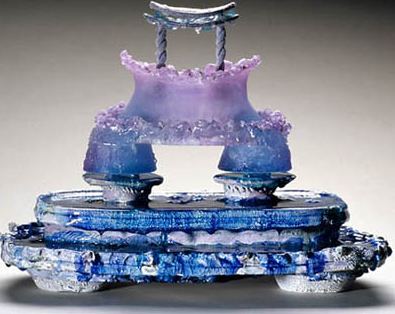 With fellow artist Kirk Bell, Lieberman created the Garden of Everyday Miracles in a vacant, overgrown lot in Fremont. When it was razed in favor of condos, Robert Zverina expressed his indignation, here. Liberman did not express hers. It existed, acquiring temples made of old TV sets, ceramic balls and pink flamingos. "Everything's temporary," she said at the time.
With fellow artist Kirk Bell, Lieberman created the Garden of Everyday Miracles in a vacant, overgrown lot in Fremont. When it was razed in favor of condos, Robert Zverina expressed his indignation, here. Liberman did not express hers. It existed, acquiring temples made of old TV sets, ceramic balls and pink flamingos. "Everything's temporary," she said at the time.She traveled widely, most frequently to India, Costa Rica and Nepal. One a week she met with friends who chanted through a prayed service. Her work is in the collections of the Fred Jones Junior Museum of Art, University of Oklahoma, OK, the Johnson County College/Nerman Museum of Contemporary Art, KS, and the Museum of Northwest Art. In Seattle she is represented by the Patricia Cameron Gallery.
She is survived by her parents William. S. Lieberman and Mae Samuelson Lieberman, both of Mercer Island; her sister Joan, brother-in-law John, nephew Alex and niece Danielle of Bellevue. A memorial service will be held on March 23 at 2 p.m. at Seattle Unity Church, 200 8th Ave. N., with a reception to follow.
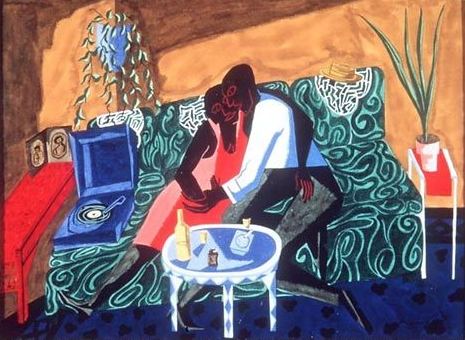 Robert Colescott, Love Makes the World Go Round, oil/canvas 1985
Robert Colescott, Love Makes the World Go Round, oil/canvas 1985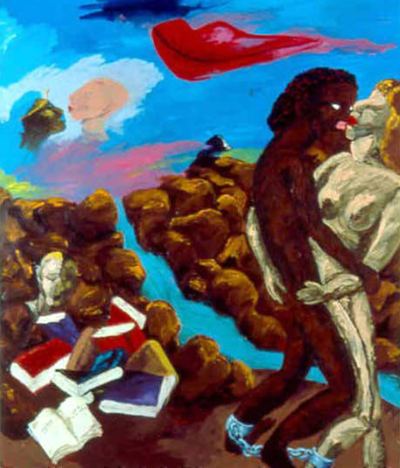 Oliver Jackson, Untitled, 1988 Intaglio drypoint: ink on Arches cover white paper
Oliver Jackson, Untitled, 1988 Intaglio drypoint: ink on Arches cover white paper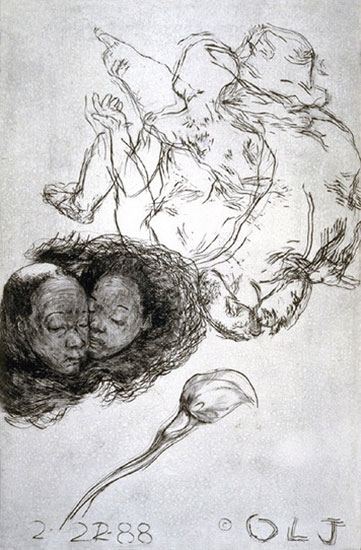 Chris Ofili, Douen's Dance, 2007, oil on linen (image via)
Chris Ofili, Douen's Dance, 2007, oil on linen (image via)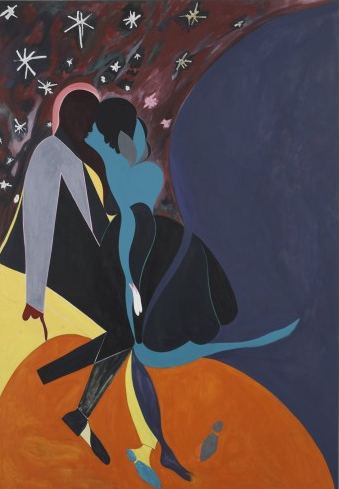
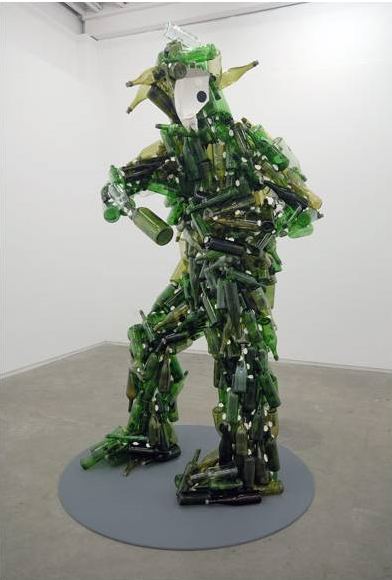 Jerry Pethick's Le Semeur/Sunlight and Flies, 1984/2002, is at the Seattle Art Museum as a solitary representative of the artist's career.
Jerry Pethick's Le Semeur/Sunlight and Flies, 1984/2002, is at the Seattle Art Museum as a solitary representative of the artist's career. Born in 1935, Pethick died in his home of brain cancer on Hornby Island in 2003. He's affiliated in Vancouver with the Catriona Jeffries Gallery, which means he is far from overlooked. Why is it, then, that so few Seattle artists under 40 know who he is? (And I'm thinking of the ones who are using his ideas.)
That's what retrospectives are for. Even if it only traveled in the Northwest, rattling through museums and art centers from Vancouver B.C. to Eugene, it would serve to introduce a new generation to a man who gave structure to their region's aesthetic thinking.
I've heard him called a glass artist, and that's true if glass art extends to cover optical lenses, Styrofoam, solar panels, found objects, photos on transparent plastic, diffraction foils, holographs, silicone and straw. He had a head full of celestial things but never failed to find beauty in a rusty bucket lying in a ditch.
More Pethick, from Catriona Jeffries.
Wheelbarrow & Cabin, 1987-1988 Glass, plastic fresnel lens, instamatic photos, florescent light fixtures, silicone, aluminum
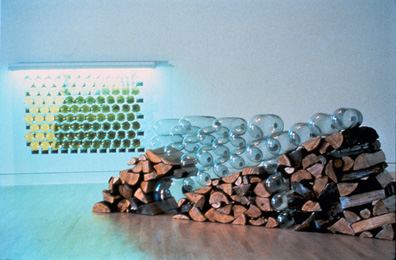 A History for Greg (Mountie Red), 1993-1995
Canvas, felt, paper, spectrafoil, photographs, silicon, graphite and postcards
A History for Greg (Mountie Red), 1993-1995
Canvas, felt, paper, spectrafoil, photographs, silicon, graphite and postcards Black Retort Travelogue, 1991/1992
Crayon, spectrafoil, wood, plastic (fishing lure), pen, plastic, metal
Black Retort Travelogue, 1991/1992
Crayon, spectrafoil, wood, plastic (fishing lure), pen, plastic, metal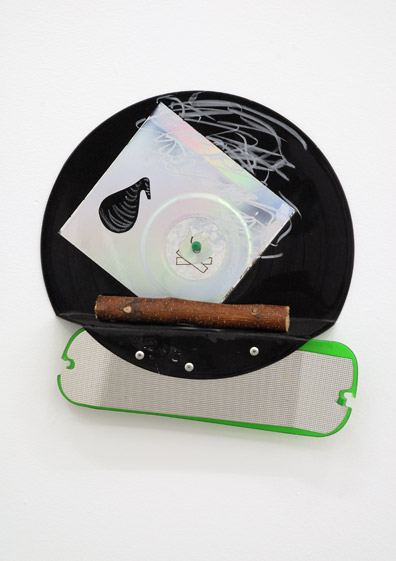
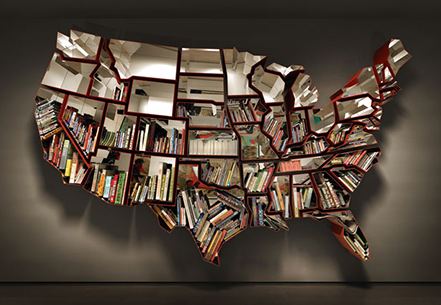
What follows is a small survey of artists whose visual exhortations and aphorisms deserve to be cited.
Dave McKenzie, Self-Help Hyperventilation Bag, 2002 (Image via)
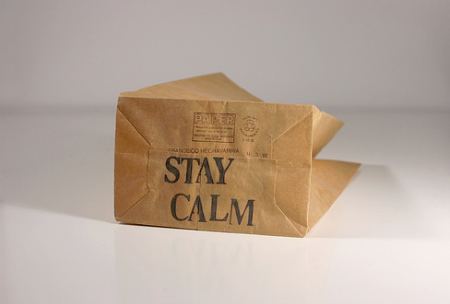 Shawn Wolfe, Panic Now
Shawn Wolfe, Panic Now Zack Bent, 2007
Zack Bent, 2007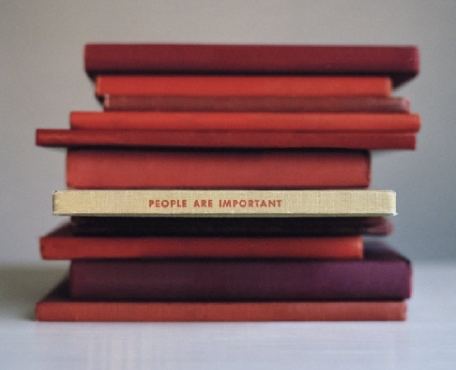 Charles LaBelle Exterior Song, (detail) Hollywood, (Cracked Actor), Alley W Fairfaix N Beverly 2003
Charles LaBelle Exterior Song, (detail) Hollywood, (Cracked Actor), Alley W Fairfaix N Beverly 2003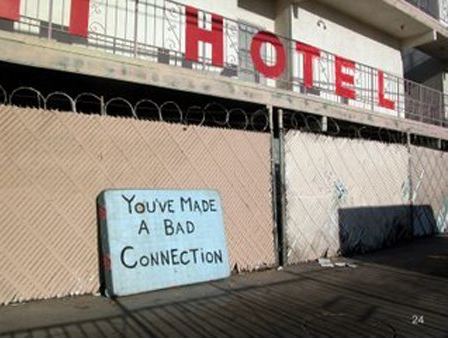 Scott Wayne Indiana
Scott Wayne Indiana Jason Hirata, Untitled, from video, 2008
Jason Hirata, Untitled, from video, 2008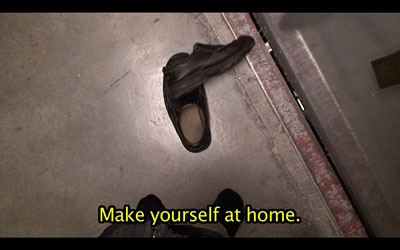 Marc Dombrosky Get Signatures/Drop Tub 2009, Embroidery on found paper, 5 x 3 inches
Marc Dombrosky Get Signatures/Drop Tub 2009, Embroidery on found paper, 5 x 3 inches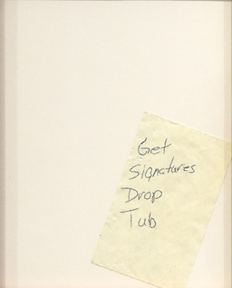 Squeak Carnwath, Good Ideas, 2006, Intaglio print, ed. 24, 12 x 12 inches
Squeak Carnwath, Good Ideas, 2006, Intaglio print, ed. 24, 12 x 12 inches 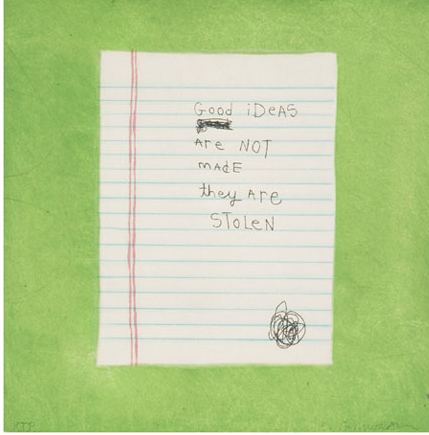 Mark Mumford, Break it Down, 2004 Color Lamda print, 40 x 29 inches
Mark Mumford, Break it Down, 2004 Color Lamda print, 40 x 29 inches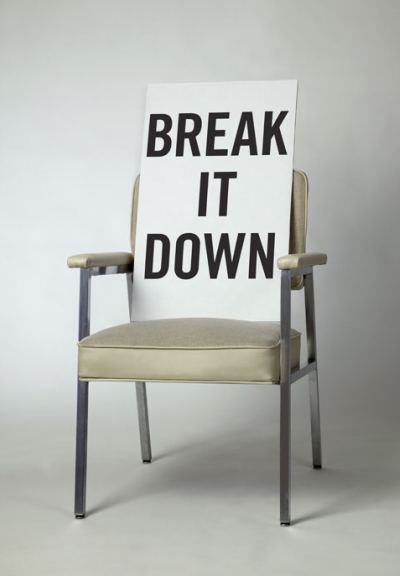 Allison Manch, Wink
Allison Manch, Wink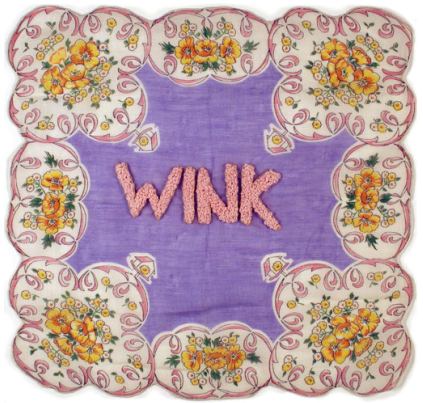 The Art Guys
The Art Guys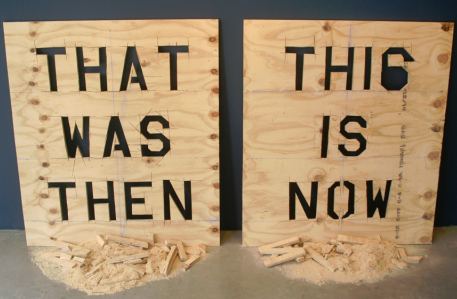 Grant Barnhart, Beg For It, exhibit announcement card, Ambach & Rice
Grant Barnhart, Beg For It, exhibit announcement card, Ambach & Rice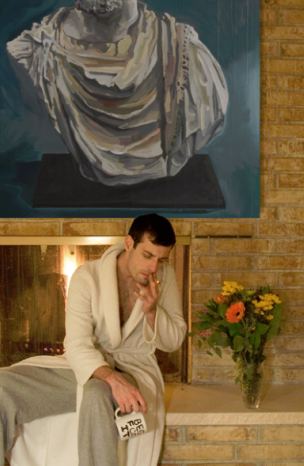
His map:
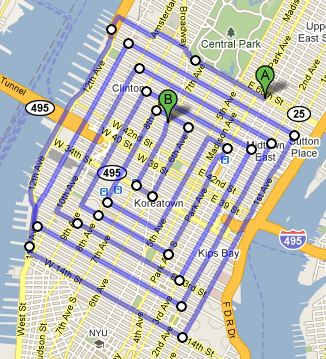 Another view of the confrontation, Michael Spafford's Minotaur & Maiden I, 1987, oil/paper, 28 x 18 inches. (Note the red stairs.)
Another view of the confrontation, Michael Spafford's Minotaur & Maiden I, 1987, oil/paper, 28 x 18 inches. (Note the red stairs.)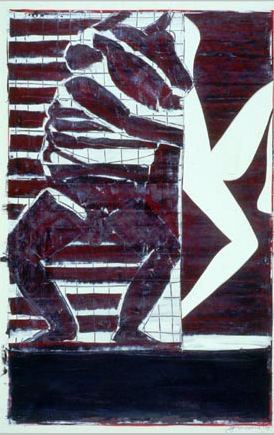
The more daring brides turn their bachelors into spectacle.
In 1999, Maurizio Cattelan taped Massimo De Carlo to a wall. The following year, Cattelan talked Emmanuel Perrotin into spending a month dressed as a pink phallus.
Making a spectacle of one's dealer has taken a more intimate turn in Seattle.
Susan Robb's DIGESTER (2008) is six 55-gallon drums designed to extract methane from human waste to make energy. The waste in question came from her dealer, Scott Lawrimore of Lawrimore Project. (Waste not, want not.)
 Opening February 20 at the James Harris Gallery are the line drawings of Jason Hirata, made by mixing sweat with raw Prussian blue pigment.
Opening February 20 at the James Harris Gallery are the line drawings of Jason Hirata, made by mixing sweat with raw Prussian blue pigment. James Harris:
To create the works on view in this exhibition, the artist and gallerist worked up a sweat doing jumping jacks, sit-ups and push-ups, jumping rope, and running down the hallways of a storage facility that Hirata rented for just such purpose. As he has done in the past, Hirata collected perspiration in two containers to use as a painting medium. The artist and gallerist collected their own sweat by scraping it from their foreheads, necks, and backs.(Hirata left, dealer right)
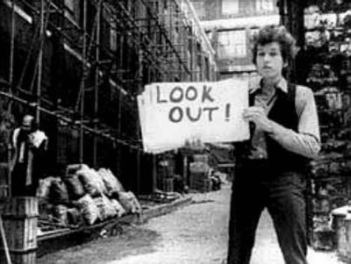 Euan MacDonald's headless tribute (the video, Where Flamingos Fly, 2005) has no similar loose ends. MacDonald eliminates what he can, including, on occasion, the point.
Euan MacDonald's headless tribute (the video, Where Flamingos Fly, 2005) has no similar loose ends. MacDonald eliminates what he can, including, on occasion, the point. 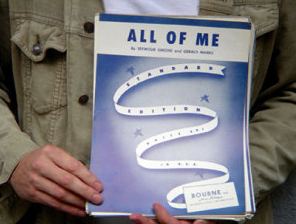 At the opening of MacDonald's exhibit at Western Bridge, A Little Ramble, bewilderment prevailed. The question in the air could be succinctly summarized as, What?
MacDonald's work is full of narrative, but its connections with
hundreds at a party are hard to discern. He makes sense one on
one. In a crowd, his work is mute, even when it's taking up almost all
the room.
At the opening of MacDonald's exhibit at Western Bridge, A Little Ramble, bewilderment prevailed. The question in the air could be succinctly summarized as, What?
MacDonald's work is full of narrative, but its connections with
hundreds at a party are hard to discern. He makes sense one on
one. In a crowd, his work is mute, even when it's taking up almost all
the room.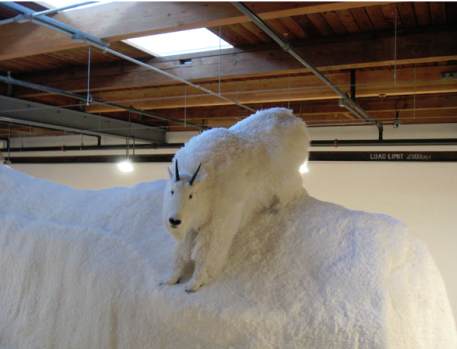 One
on one, however, a mood emerges. The birds have eaten the bread crumbs
leading out of the forest. No, they've eaten the forest. It's there and
not there. What swells around the consciousness of the solitary viewer
is anti-climatic. The artist who isn't there is a tour guide to a
mystery. In his absence, he left notes for a reassuring brochure. These
notes might be helpful. They look as if they are intended to be
helpful, but they're in code.
One
on one, however, a mood emerges. The birds have eaten the bread crumbs
leading out of the forest. No, they've eaten the forest. It's there and
not there. What swells around the consciousness of the solitary viewer
is anti-climatic. The artist who isn't there is a tour guide to a
mystery. In his absence, he left notes for a reassuring brochure. These
notes might be helpful. They look as if they are intended to be
helpful, but they're in code.
Continue reading Euan MacDonald - the banality of art.
SuttonBeresCuller
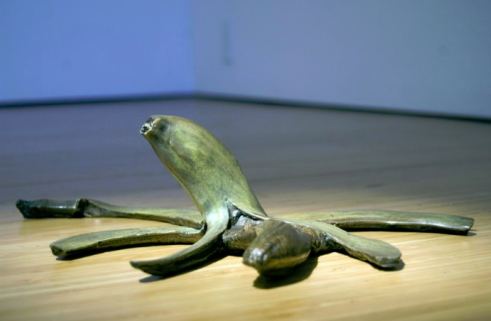
Continue reading The banana downfall - a visual survey.
Review here. Frquently asked questions below.
- Q: Doesn't the first sale doctrine prevent you from collecting further payment past the initial sale of the item?
A: In order to be recognized as a work of art the contract must be adhered to, and regards of who owns it and who buys it the contract remains between the artist and the purchaser, not between buyer and seller.
Continue reading The endless art auction on eBay.
Those who work in that world shovel the present into the past as a kind of necessary clean-up. For market reasons disguised as aesthetics, key power players determine who among the previously celebrated remains a live wire. The rest will be regulated to the heap of has-beens, to be humiliated and disappeared. Only live wires make the market hum.
Even as they rose like surface to air missiles to art world's stratospheres, Tim Rollins and K.O.S. lived with an undertow of detractors, those who thought somebody was being exploited here and it could well be them for taking this project seriously.
How could it be taken seriously? The odds against it are impossible.
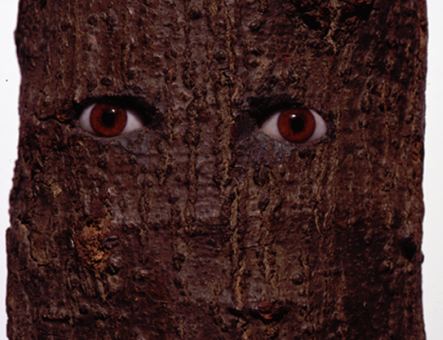 In 1981, when collectors were drinking pink champagne out of glass slippers at the Mary Boone Gallery, a serious student of the Rev. Martin Luther King Jr., John Dewey and Joseph Kosuth stepped off the subway in the South Bronx to the smell of the burning garbage.
In 1981, when collectors were drinking pink champagne out of glass slippers at the Mary Boone Gallery, a serious student of the Rev. Martin Luther King Jr., John Dewey and Joseph Kosuth stepped off the subway in the South Bronx to the smell of the burning garbage.
Continue reading Tim Rollins & K.O.S. - courage, vision and durability.
If American history is hard to read, it's because the country's aspirations fall so far short of its practices. Textbooks tend to respond with cover-ups, but not ones written by Zinn. A People's History of the United States is a courage teacher. Not only is it scholarly, clear and elegantly written from original source materials, its focus is justice: how and when it was denied and how and when it was achieved. His outrage is accompanied by his hope, wit and patriotism.
Below, a scene from Deb Ellis and Denis Mueller's fine documentary titled, Howard Zinn: You Can't Be Neutral on a Moving Train. (To purchase, go here.)
.
He started out strong as a figurative painter in the 1930s. Forging a silky yet monumental style, he created men to match Northwest mountains. He liked muscle-bound grandeur but released the figures who displayed it from the confines of gravity. Full of light, many hover on the edge of floating away.
By the 1940s, he had pinned his figures to the ground with webbing. There are excellent paintings from this period, but by the late 1960s, he was more interested in abstractions. By the 1970s, his work had taken a brazenly ugly turn, with hot strokes of orange against blood brown and crinkled masses of shadows.
Bad taste is a fatal flaw in a decorator, but in an artist it's neutral. Artists who fully inhabit their bad taste take it to another realm, where taste is irrelevant. Callahan inhabited his whenever he chose. There were moments in his career when his work was highly prized and edging its way into national prominence, and moments when even in the Northwest he was overlooked. The Northwest School's Big Four (Morris Graves, Guy Anderson, Mark Tobey and Callahan), evolved into the Big Three, with Callahan missing. If he cared, he did not let on.
A small survey of his career is currently at the Woodside/Braseth Gallery, from the 1940s through the 1980s. (He died in 1986 in his early 80s.) All the best work is missing, but what's here is swell. The exhibit is light on the abstractions that lost him so many fair-weather friends and concentrates on what everyone admires: his sumi inks, oil portraits of animals and small, florid landscapes.
North Lake Camp, early 1950s, sumi ink. 35 x 46 inches. Imagine that the image the gallery supplied is on white paper in black ink. The sepia tone appears to have arisen from the process of transmittal. At any rate, the fallen cabin on the left belonged to Guy Anderson. Callahan sketched it soon after its demise, when the snow that brought it down had started to clear. The trees moving in and out of focus have a skittery grace. They lean into the light as if they're starved for it.
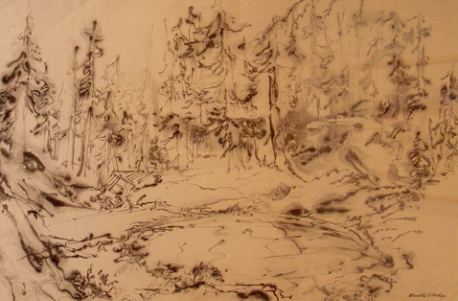
Continue reading Kenneth Callahan - painting the earth.
The series started last year with 1977, below. (The last good kiss you had was years ago.)
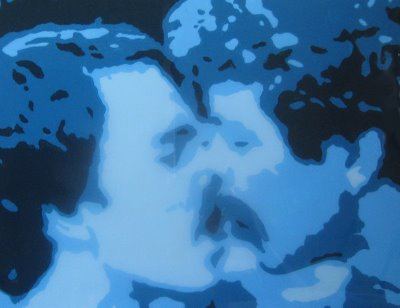 Bear is more recent. It appears to be a self-portrait. (I am the name of my desire.)
Bear is more recent. It appears to be a self-portrait. (I am the name of my desire.)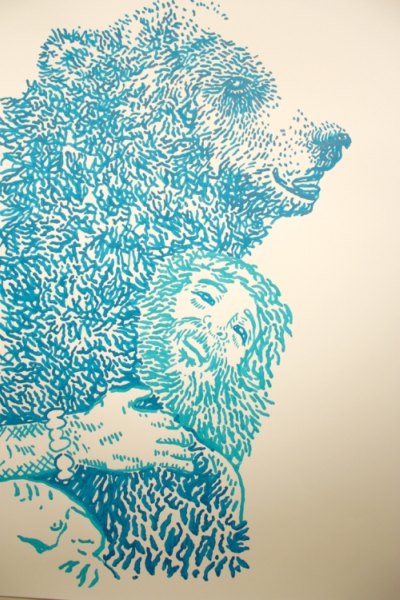 Hunter toys with the stereotype, with what it means to be male.
Hunter toys with the stereotype, with what it means to be male.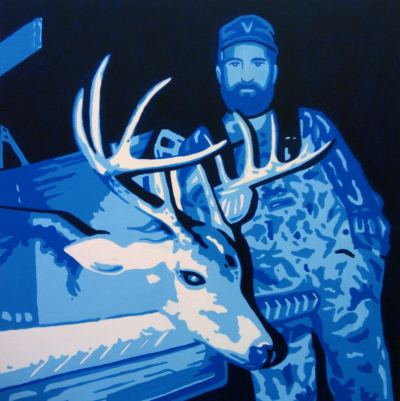 Cowboy celebrates the fun. Note the underwear. This isn't your grandmother's cowboy.
Cowboy celebrates the fun. Note the underwear. This isn't your grandmother's cowboy. 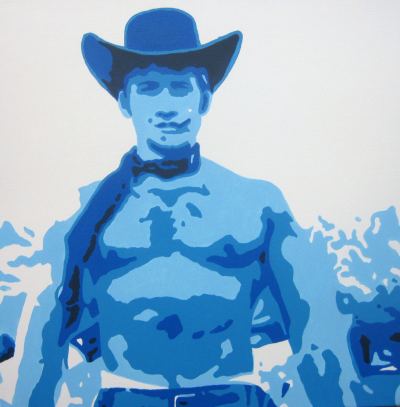 These images and others are on Veltkamp's flicker stream, here. He also fronts an excellent blog known as Best Of. Before Best Of, Veltkamp was known primarily as an illustrator. In Seattle, he was around but not central.
These images and others are on Veltkamp's flicker stream, here. He also fronts an excellent blog known as Best Of. Before Best Of, Veltkamp was known primarily as an illustrator. In Seattle, he was around but not central. The blog allowed him to introduce himself to those who thought they already knew him. With his generosity, wit and ability to engage with the work of other artists, he raised curiosity about what he seldom alludes to - his own work. Partly due to all that engagement, his own work has improved.
Those who bemoan the death of print and the rise of online journalism fail to realize how static print is. Before blogs, somebody like Veltkamp would have had few options to express himself. Newspapers had no room for him. He doesn't fit their formula. I loved working for a newspaper, but I don't miss the paper part. Let the trees live.
 His work can look like nothing at all, tidbits left over from an elementary school art class. What makes it distinctive is time spent. Stand in front of them long enough, and these fragments become wholes. They evoke not rocks on a beach but scholar's rocks in a studio, each plane and color pattern worthy of attention.
His work can look like nothing at all, tidbits left over from an elementary school art class. What makes it distinctive is time spent. Stand in front of them long enough, and these fragments become wholes. They evoke not rocks on a beach but scholar's rocks in a studio, each plane and color pattern worthy of attention. Nyland is in Soil's back room through Saturday. In the front gallery is a terrific new members show featuring Iole Alessandrini, Julie Alpert and Ellen Ziegler, also through Saturday.
Outside The Time Zone, the curatorial partnership between Chris Rawson and Julian Calero, is pleased to announce its first collaborative project outside of New York City. The exhibition is also the inaugural exhibition for Kymata Project Space. Seattle was chosen as the first host city because the exhibited artists and the curators have intimate connections with the Emerald City and the Northwest. The four-person exhibition of new work by Chris Burnside, Garek Druss, Ben Needham and Adam Taye is conceived as a meditation on landscape and is inspired by the act of homecoming, travel and displacement, which are themes prevalent in OTZ's ongoing nomadic curatorial project.They couldn't have too many ties in Seattle or they wouldn't call it the Emerald City. That's a marketing term, the equivalent of The Big Apple. Those who use it are on the take, out of it or kidding. At any rate, welcome. They open Feb. 11, 6-8 p.m. at 340 15th Ave. E Suite 305.
Chris Burnside, acrylic painted directly on the wall, 2003
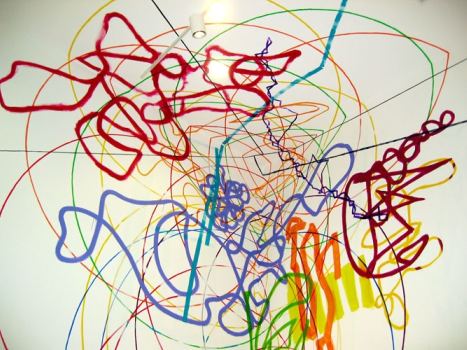
To date (and time is running out), the event promises to be free form. We have yet to discuss content, but I'm assuming it relates in some form to arts journalism. Maybe he'll surprise me and ask about baseball. I could change the topic to fine wine and dining or string theory and still be at sea. Arts journalism it is.
In 1969 (Ida) Applebroog, then known by her married name, Ida Horowitz, was a mother of four, a native New Yorker living unhappily in San Diego, where her husband had moved the family to accept an academic position. Ms. Applebroog had been struggling to make a name for herself as an artist and struggling with depression. Her only sanctuary in her chaotic household came at night, when she shut herself in the bathroom and climbed into the tub.Now in her 80s, she found the drawings again, which she scanned into a computer and manipulated, printing them on Japanese paper recast with watercolor. (At Hauser & Wirth till March 6.)
Over a period of several weeks just before her 40th birthday, she took a sketch pad into the bathroom with her too and perched in front of a full-length mirror, making obsessive self-portraits, more than 150 in all, but portraits focused exclusively on her naked crotch. (more)
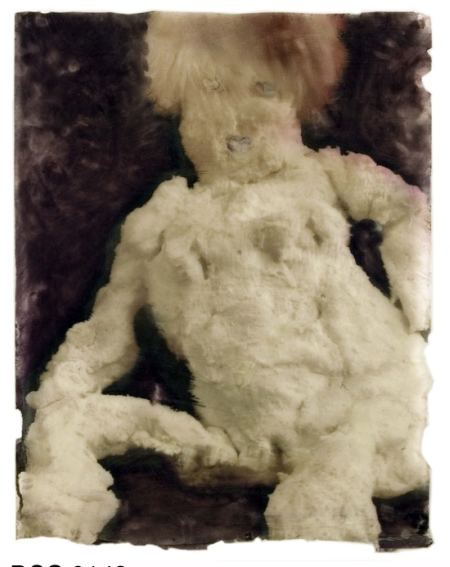
Applebroog comes from hearty stock. Her sister, the artist Gloria Bornstein, lives in Seattle. The difference between them is similar to something John Updike once wrote about his generation and the one that emerged in the late 1960s. His was interested in forestalling apocalypse and the latter in bringing it on. In the analogy, Bornstein is Updike, and her older sister is hell-no-we-won't-go.
Bornstein, Concupiscence, 2002, collection, Seattle Art Museum
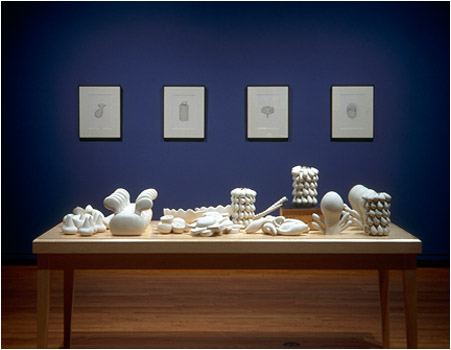 Adrian Searle on Christian Boltanski installation - a rag and bone shop of the heart:
Adrian Searle on Christian Boltanski installation - a rag and bone shop of the heart:
Elementary, you say? And yet good critics continue to write as if chromosomes determine position. Case in point, Judith H. Dobrzynski on her blog, Real Clear Arts:
Bornstein, Concupiscence, 2002, collection, Seattle Art Museum
 Adrian Searle on Christian Boltanski installation - a rag and bone shop of the heart:
Adrian Searle on Christian Boltanski installation - a rag and bone shop of the heart:These sounds are all human heartbeats. Visitors can make their own contribution by having their heart rhythms recorded by white-coated technicians in booths off the main space. Boltanski, one of France's leading artists, is compiling an archive of heartbeats that he intends to be housed, eventually, on a remote and inaccessible Japanese island. He has already collected over 15,000 individual recordings. One day, these beating hearts will all belong to the dead. If Boltanski's art endures, one might also imagine that the visitors who make it to the island in the future have yet to be born. (more)Just because a curator or gallerist is a woman doesn't mean she is going to be sympathetic to women artists. The person who's done more (post- Guerrilla Girls) to shame art institutions into including more women artists is Jerry Saltz. Whatever anyone wants to say about him, we can all agree that's he's a he.
Elementary, you say? And yet good critics continue to write as if chromosomes determine position. Case in point, Judith H. Dobrzynski on her blog, Real Clear Arts:
This week, Pinchuk announced the prize's jury. Among the seven members, again, just one woman -- (Yuko) Hasegawa), Chief Curator of the Museum of Contemporary Art Tokyo (MOT); former Chief Curator of the 21st Century Museum of Contemporary Art, Kanazawa. That mix is hardly representative of the art world, and it's a snub to the talented female curators, museum directors, critics, academics, dealers and collectors that populate the art world. Not to mention female artists.Judith: Daniel Birnbaum is pretty good on this issue and Robert Storr is excellent. Possession of a vagina guarantees nothing. The interesting thing about this panel is that both Storr and Okwui Enwezor are on it. Unfortunately not online is their highly entertaining exchange of insults and insights in the letters-to-the-editor space in Artforum, 2008. If they're meeting in the same room, somebody needs to sneak in a camera.
Let's hope Hasegawa has a strong voice. She'll need it among these other jurors: Daniel Birnbaum (Sweden) - Director of the Städelschule Art Academy, Frankfurt am Main; Director of the Venice Biennale 2009 * Okwui Enwezor (Nigeria) - Director of Documenta XI; former Dean of Academic Affairs and Senior Vice President at San Francisco Art Institute * Ivo Mesquita (Brazil) - Chief Curator at the Pinacoteca do Estado de São Paulo; Curator of the 2008 São Paolo Biennial * Eckhard Schneider (Germany) - General Director of the PinchukArtCentre * Robert Storr (USA) - Dean of the Yale University School of Art; Director of the Venice Biennale 2007 * Ai Weiwei (China) - artist. (more)
The Museum on Fire makes a sensible comparison - Walter Hopps and Jeffry Deitch, both dealers turned museum curators.
Joanne Mattera on the perils of storing images electronically.
Two Coats of Paint on the demise of Art on Paper.
Jonathan Melber on the Brooklyn Art Museum's progressive, public-friendly copyright policies, via NEWSgrist.
Seattle's John Morefield, an out-of-work architectural designer, set up an architectural advice booth (5 cents) at the Ballard Farmer's Market and got covered in the New York Times.
Liz Stone, who identifies herself as a web master for the Seattle Art Museum, wrote about some of the negative mail that finds its way to her inbox. (Note to Stone: The writer who called SAM's site boring was being kind.)
Seattlle artist Amanda Manitach is off to a good start with a blog titled, my heroes died of syphilis, via Translinguistic Other.
Christopher Buening, Methhead
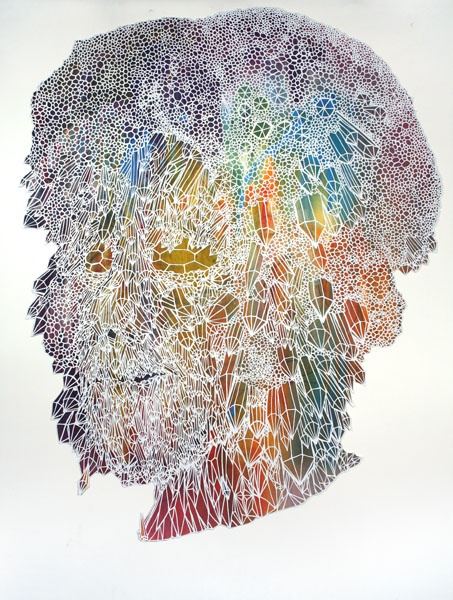 Not as lovely, but far more likely to be loitering around:
Not as lovely, but far more likely to be loitering around: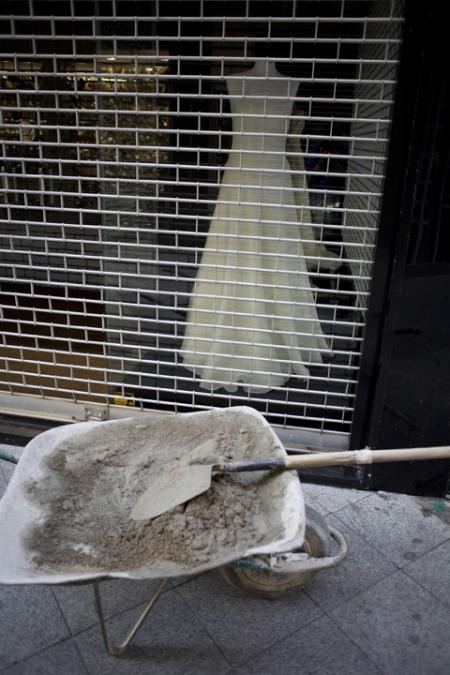
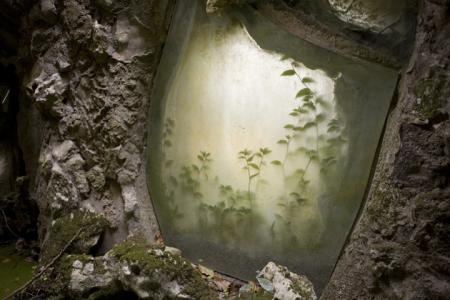
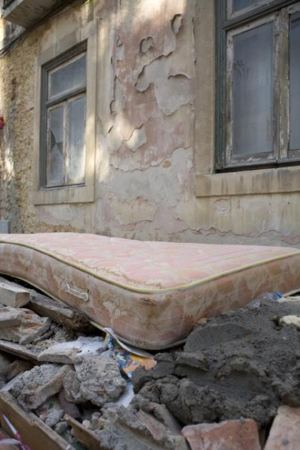 At Elizabeth Leach through Jan. 30. Interview with Christopher about his father, Robert, after the latter's death in 2008, here. Podcast interview with Eva Lake (30 minutes, worth it), here.
At Elizabeth Leach through Jan. 30. Interview with Christopher about his father, Robert, after the latter's death in 2008, here. Podcast interview with Eva Lake (30 minutes, worth it), here.Leo Kenney, Formation No. 4, New Center, 1966 (At Seattle artREsource)
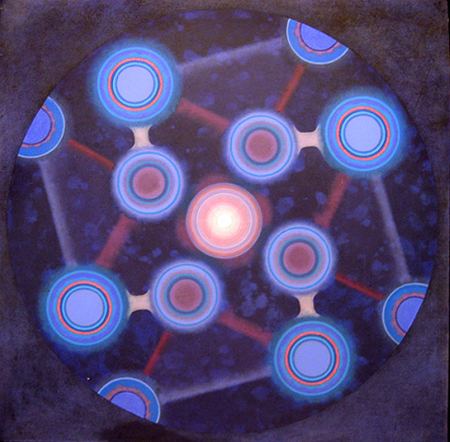 Jeffrey Simmons, Proxima, 2008 (At Greg Kucera)
Jeffrey Simmons, Proxima, 2008 (At Greg Kucera)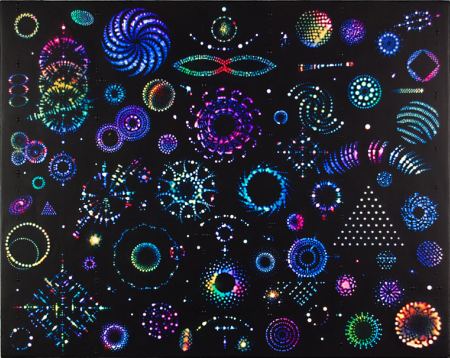
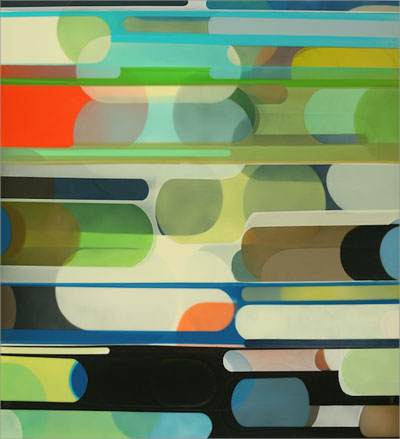

With homespun domestic skill, he returns trash to the bosom of the family. Lost or tossed messages are upgraded into a kind of street poetry.
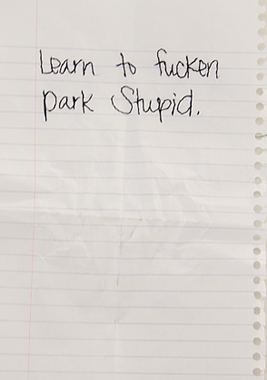

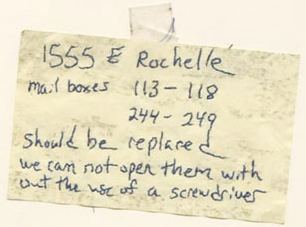 Lately, Dombrosky has moved beyond saving the written word to saving thrown-away tarps and corny t-shirts. Beside eroded gold lettering, King of Pop, is a hand-embroidered black mass: The King of Pop develops a goiter.
Lately, Dombrosky has moved beyond saving the written word to saving thrown-away tarps and corny t-shirts. Beside eroded gold lettering, King of Pop, is a hand-embroidered black mass: The King of Pop develops a goiter. 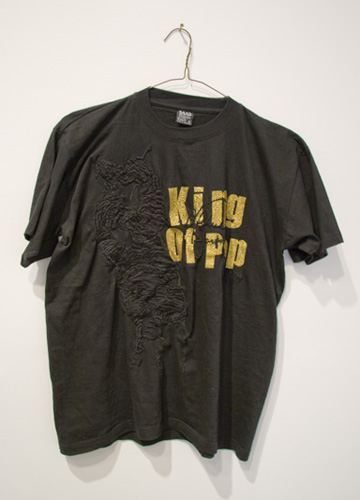 Dombrosky's Neverland at Platform Gallery through Feb. 20.
Dombrosky's Neverland at Platform Gallery through Feb. 20.Rumor had it that Fred carried Kenneth Fearing's Dirge in his pocket.
One day, Fred's fortunes rose. He had scored a summer job as life guard at a posh LA hotel. The pay was great, the work light and the atmosphere relaxing. What could go wrong? On the first day, arriving as dawn broke, he found a corpse floating face down in the water. Because he failed to jump in to check for vital signs, he never got a chance to sit in the life guard station.1-2-3 was the number he played but today the number came 3-2-1;bought his Carbide at 30 and it went to 29; had the favorite at Bowie but the track was slow--
Looking at Amir Zaki's digitally manipulated and color-saturated photos of life guard towers in L.A., Fred came to mind.
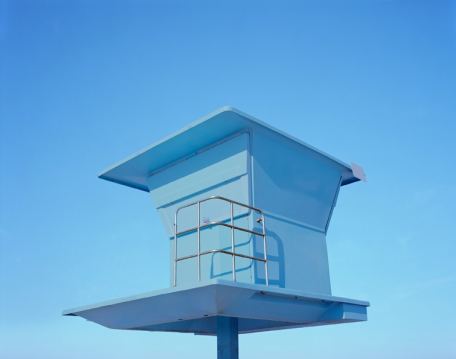 Not only is no one there, no one could be there.
Not only is no one there, no one could be there. They are cool-school emblems of futility, a perfect match for Raymond Chandler's view of swimming pools, a world away from David Hockney's:
They are cool-school emblems of futility, a perfect match for Raymond Chandler's view of swimming pools, a world away from David Hockney's:Nothing is emptier than an empty swimming pool.At James Harris Gallery through Feb. 20
The business of America is business.Andy Warhol
Making money is art and working is art and good business is the best art.Caleb Larsen
Pay my (art-related) credit card debt.
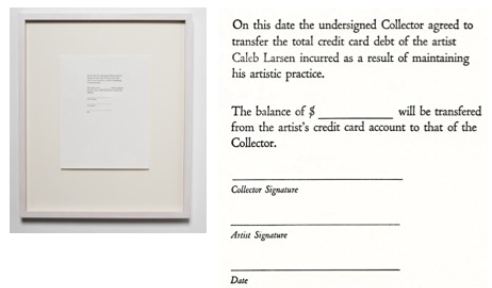
In
the 1970s, Sol LeWitt placed a drawing in a box which he buried and
wouldn't say where. The absence of the drawing did not deter its sale,
in the form of a certificate of ownership. If the same reasoning
applied to cars, you could pay for the car and ride away on the credit
card receipt. Unlike war, cars, cats, weather and the kitchen table,
art still functions even if it's only in the mind.
All art has its own niche. Larsen has staked his in a narrow band of comic process.
A Tool To Deceive And Slaughter is a black box that will always be attempting to auction itself off on eBay. The collector who acquires it has to agree to relinquish it if another offers a bid higher than the owner's purchase price, and so on, forever. It's an answer of sorts to Robert Morris's Box With the Sound of Its Own Making from 1961, owned by the Seattle Art Museum. Larsen's is a box with the sound of its own selling.
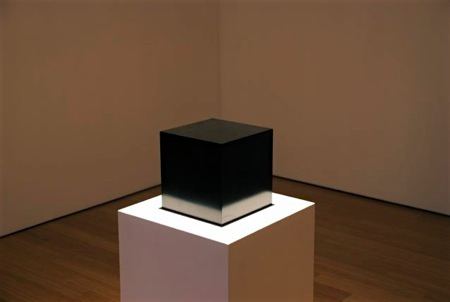 The Entire Contents Of The Pen
(1,604 Linear Foot Drawing). Starting with a fresh fountain pen, Larsen
drew on an 9 x 12 inch piece of paper until the pen ran dry.
The Entire Contents Of The Pen
(1,604 Linear Foot Drawing). Starting with a fresh fountain pen, Larsen
drew on an 9 x 12 inch piece of paper until the pen ran dry.
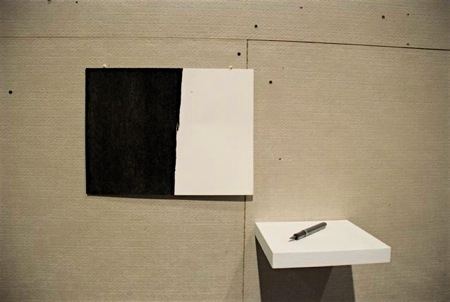 My favorite
My favorite scam
sculpture in the show is titled, $10,000 Sculpture (In Progress). It
accepts your money, and gives you nothing back. I slipped it three
dollar bills before coming to my senses. When there is so much in life
that disappoints in spite of our best efforts, it is positively
exhilarating to volunteer to be scammed, eyes wide open.
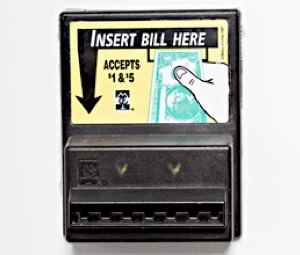 At Lawrimore Project through Feb. 13.
At Lawrimore Project through Feb. 13.
All art has its own niche. Larsen has staked his in a narrow band of comic process.
A Tool To Deceive And Slaughter is a black box that will always be attempting to auction itself off on eBay. The collector who acquires it has to agree to relinquish it if another offers a bid higher than the owner's purchase price, and so on, forever. It's an answer of sorts to Robert Morris's Box With the Sound of Its Own Making from 1961, owned by the Seattle Art Museum. Larsen's is a box with the sound of its own selling.
 The Entire Contents Of The Pen
(1,604 Linear Foot Drawing). Starting with a fresh fountain pen, Larsen
drew on an 9 x 12 inch piece of paper until the pen ran dry.
The Entire Contents Of The Pen
(1,604 Linear Foot Drawing). Starting with a fresh fountain pen, Larsen
drew on an 9 x 12 inch piece of paper until the pen ran dry. The drawing now contains everything that the pen once was.Looks a bit like a Clyfford Still, updated by means of an obsessive-compulsive back story and, of course, the pen.
 My favorite
My favorite  At Lawrimore Project through Feb. 13.
At Lawrimore Project through Feb. 13.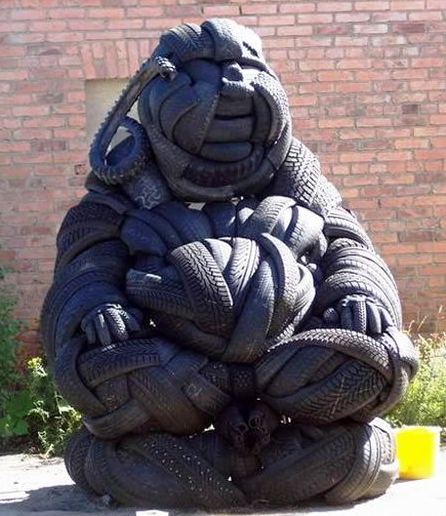 Gary Snyder, from Mother Earth: Her Whales
Gary Snyder, from Mother Earth: Her WhalesAnd Japan quibbles for words on
what kind of whales they can kill?
A once-great Buddhist nation
dribbles methyl mercury
like gonorrhea
in the sea.
...
Ah China, where are the tigers, the wild boars,
the monkeys,
like the snows of yesteryear
Gone in a mist, a flash, and the dry hard ground
Is parking space for fifty thousand trucks.
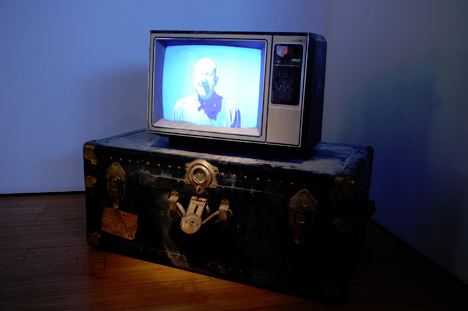 My brother once owned a dog who could sing like a saxophone. Trying to encourage a performance, I half-crooned a howl to get him in the mood. Nothing. "You have to put your heart in it," my brother said.
My brother once owned a dog who could sing like a saxophone. Trying to encourage a performance, I half-crooned a howl to get him in the mood. Nothing. "You have to put your heart in it," my brother said.Jeck puts his heart in it. Even if he'd never made anything else, for this one piece (Pathetique, 2003) he'd deserve a place in art's memory bank.
But that's not all. Jeck's After Muybridge 2007 - suite of 9 photos of clay figures morphing from one frame to another - hangs on a wall.
 Detail:
Detail: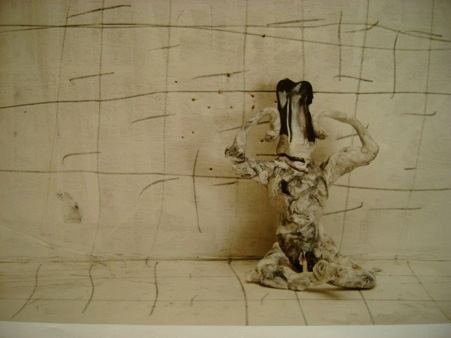 Muybridge documented motion and Jeck breakdown. There's a foolish attempt to rise again in the final frame, a burnt offering. Jeck's figures lack the resilience of Thomas Schutte's lumpen freaks from, for instance, United Enemies. Instead, the Seattle artist parodies American individualism. His tiny people are masters of their own ships and captains of their own souls with nowhere to go and no way to get there.
Muybridge documented motion and Jeck breakdown. There's a foolish attempt to rise again in the final frame, a burnt offering. Jeck's figures lack the resilience of Thomas Schutte's lumpen freaks from, for instance, United Enemies. Instead, the Seattle artist parodies American individualism. His tiny people are masters of their own ships and captains of their own souls with nowhere to go and no way to get there.Jeck is part of Wet and Leatherhard at Lawrimore Project, curated by Susie J. Lee. Instead of final products, Lee looks at process, at what a devotion to the muck of the earth does to contemporary artists.
Photos and a video document a 1972 performance by Jim Melchert and his friends. They stuck their heads in buckets of wet clay and waited for it to dry. Kristen Morgin recreates old tin toys with unfired replicas, the new far more fragile than the old. Wynne Greenwood's attempts at a vessel wouldn't pass muster at summer camp, yet like the obese in bikinis, their bloated splendor insists on attention.
For Tim Roda, Meiro Koizumi and Ben Waterman, clay is a prop for performance. For Sterling Ruby, the ultimate performance cannot be controlled. It's what happens in the firing. Artists make offerings, and the kiln decides who is Cain and who is Abel.
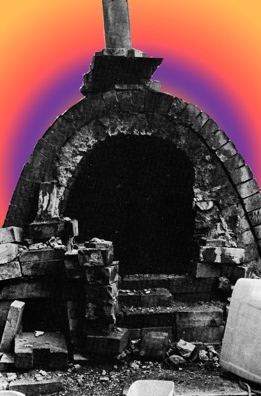 Through Feb. 13.
Through Feb. 13.Spiders decorate their webs.
Guidelines for dealing with book (or gallery/museum) assistants, via Paul Constant.
Art criticism for the stupid: From the London Times Online - Behind the smile Mona Lisa may have suffered from high cholesterol. It's a painting, people. Plus, everybody knows Mona is made of coffee.
From Amy Goodwin
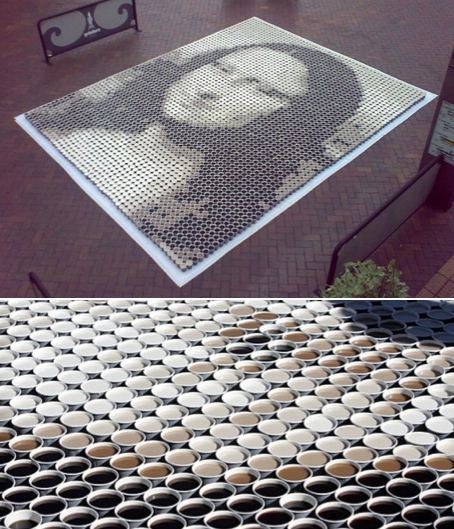 The nicest-possible-way-of-writing-a-negative-review award goes to Roberta Smith for her non-appreciation of Lynda Benglis' recent efforts.
The nicest-possible-way-of-writing-a-negative-review award goes to Roberta Smith for her non-appreciation of Lynda Benglis' recent efforts.But all innovative, driven artists -- of which Ms. Benglis is definitely one -- have comfortable ruts they periodically fall into, or pitfalls they need to avoid. This show emphasizes hers, while giving notice that in all probability she will soon be working her way out of them.Related: From NewsGrist - Ten most scathing reviews of last year. (Howard Halle, whoever that is, is dead wrong about Emily Jacir.)
The under-appreciated art blog award goes to John Perreault, whose Artopia is on ArtsJournal. Perreault's last two entries, How the West Was Won: Fetish Finish and Fakes: Have Replicas Replaced Art? are among the best things I've read anywhere about anything in the new year. Perreault refuses to rush his posts. Once a week or less is all we get from him, but he makes every word count. His complexities are polished to a rare clarity.
Most-patronizing-post-from-an-art-blogger award goes to Tyler Green for his ruminations on Byron Kim. First Green says that Kim's Synecdoche is not a great work of art. Green follows with the incredible opinion that the National Gallery of Art was right to acquire it anyway, in the interests of diversity.
Synecdoche, the Byron Kim installation acquired by the National Gallery of Art late last year, is not a great work of art. It is closer to the end of every art historical precedent it engages than it is to the beginning: abstract painting, the use of the grid, monochrome painting, abstraction-as-portraiture, minimalism, even its use of art world insiders as models to help the work 'get over,' WWE-style....I don't agree about the piece, but if I did, I wouldn't praise the National Gallery for buying it. Green seems to be supporting affirmative action for unqualified art works. Few things could be more insulting to artists of color.
Still, it is a worthwhile acquisition for the National Gallery of Art, a mostly federally-funded institution that should be collecting works of art that engage the most prominent American philosophical conversations. Synecdoche, which Kim began in 1991 and to which he has added ever since, is one of the better examples of American artists engaging with with the 1980s and 1990s debate about multiculturalism in America.
More Green: I admire Green and read his blog daily. Learn a lot. Appreciate his hustle and intelligence. But his arch attacks on Jerry Saltz are getting old. As Green reports, linking to an ARTINFO blurb, Saltz used what Green calls "a four-letter epithet" in a facebook post. It's fuck, by the way. Saltz typed the word fuck. Big fucking deal.
Stefano Catalani is now director of curatorial affairs/artistic director of the Bellevue Arts Museum, a promotion he earned. Working in an impossible building in a crafts niche, he has made his shows matter.
 Michael Brophy's paintings have good lungs. They expand to fill a sky with room left over for the land, which is frequently dark save for moonlight on water.
Michael Brophy's paintings have good lungs. They expand to fill a sky with room left over for the land, which is frequently dark save for moonlight on water. 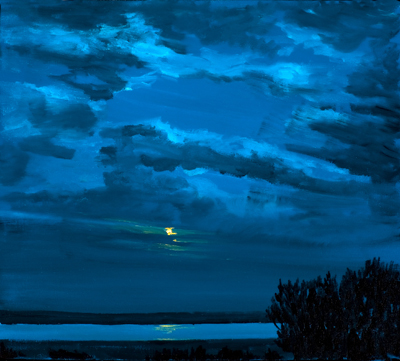
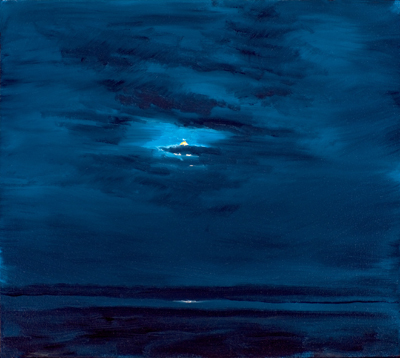
Brophy has long enjoyed regional distinction for lovely paintings of ruined grounds.
Charles D'Ambrosio described them best:
April Gornik paints big vistas as domestic interiors. Waterfalls on rocks look like cream pouring out of dark pitchers, and a stand of trees at night has a lacy edge. Alex Katz's twilight vistas look like billboards. Gayle Bard's rolling greens are immaculate, as if recently vacuumed. Elizabeth Sandvig's riotous abundance channels Fragonard. Joan Nelson's lost worlds could be carried in lockets. Robyn O'Neil's are medieval. Norman Lundin's muddy grounds are what you might see through the window of your car on a rainy day. Anselm Kiefer's wreckage marinates in the poisons of history.
Brophy's landscapes wear their nerves on the outside of their bodies. A smear of his moonlight is like a dry cough. His trees have their ears pricked, waiting for the sound of an alien step. Remote but not austere, his landscapes reject the rare figures who attempt to move within them.
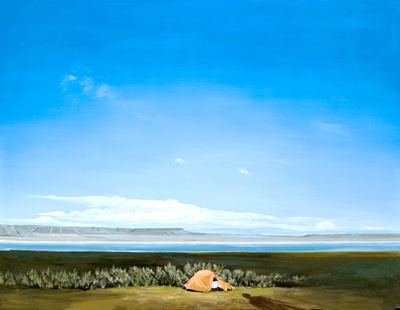 At G. Gibson Gallery through Feb. 20.
At G. Gibson Gallery through Feb. 20.
Charles D'Ambrosio described them best:
Most of Brophy's landscapes are obviously wrecked, but there's no nostalgia for the olden days, no melancholy, no sappy loss, largely because there's also no initial shock. Ruin is painted as if it were eternal, as if there were nothing to recover, as if beauty persists, generous and spacious, even when the landscape of our longing does not.The landscapes of our longing are back, both in moonlight and sunlight. For many painters, they never went away.
April Gornik paints big vistas as domestic interiors. Waterfalls on rocks look like cream pouring out of dark pitchers, and a stand of trees at night has a lacy edge. Alex Katz's twilight vistas look like billboards. Gayle Bard's rolling greens are immaculate, as if recently vacuumed. Elizabeth Sandvig's riotous abundance channels Fragonard. Joan Nelson's lost worlds could be carried in lockets. Robyn O'Neil's are medieval. Norman Lundin's muddy grounds are what you might see through the window of your car on a rainy day. Anselm Kiefer's wreckage marinates in the poisons of history.
Brophy's landscapes wear their nerves on the outside of their bodies. A smear of his moonlight is like a dry cough. His trees have their ears pricked, waiting for the sound of an alien step. Remote but not austere, his landscapes reject the rare figures who attempt to move within them.
 At G. Gibson Gallery through Feb. 20.
At G. Gibson Gallery through Feb. 20.Walking home one night, she saw smashed beer bottles in the street, pieces of glass held together by the adhesive of the label beneath them. Reflected party lights turned them into jewels. The stars she could see were not in the sky but under her feet.
Night, Sleep, Death and the Stars, 2010 glass plastic bag
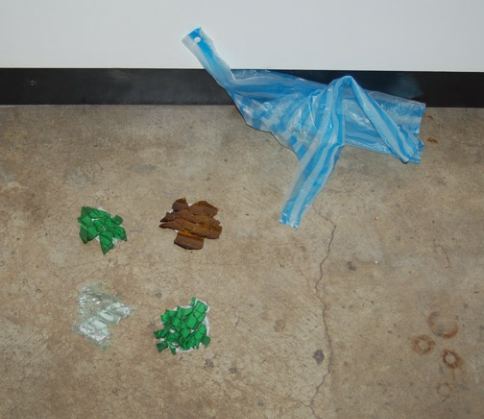 "No ideas but in things," wrote William Carlos Williams, early in the 20th century. Early in the 21st, the idea continues to have resonance.
"No ideas but in things," wrote William Carlos Williams, early in the 20th century. Early in the 21st, the idea continues to have resonance. Bennett is interested in decay and repetition as an affirmative position - an eroded X marks her spot. Like many in her generation, she offers an open-ended approach to materials instead of a specific style, in her case especially materials that have kicked around the edges of urban cultures, such as fake wood grain and skateboard decals. Her drawings in colored pencil are based on images that are past their technical prime and have been reproduced nearly to death, frayed and blurred instead of specific.
The Dull Flame of Desire, 2010, prisma color pencil on paper 22 x 30.5 inches
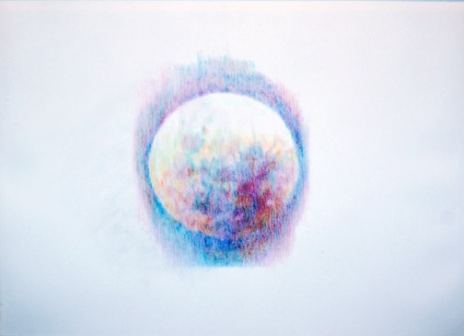 Ghost Dog 2010 prisma color pencil on paper 26 x 26 inches
Ghost Dog 2010 prisma color pencil on paper 26 x 26 inches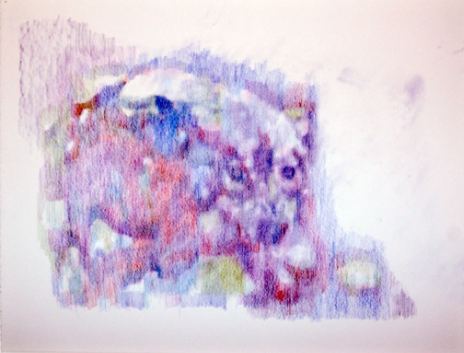 Her current exhibit at Howard House takes its titled, Community World Theater, from a movie theater in Tacoma, Washington, that served as a pivotal site for dozens of punk concerts in 1987 to 1988. An earlier series of drawings treated Kurt Cobain as a kind of J.M.W. Turner weather-event - atmosphere overtaking concrete form.
Her current exhibit at Howard House takes its titled, Community World Theater, from a movie theater in Tacoma, Washington, that served as a pivotal site for dozens of punk concerts in 1987 to 1988. An earlier series of drawings treated Kurt Cobain as a kind of J.M.W. Turner weather-event - atmosphere overtaking concrete form. In Iceland in a semi-permanent gray dark, she began to think of a culture whose recesses could be staged. In the dark, stage light is the sun. A generous use of it includes all the ordinarily lost moments. It can celebrate not just a performance but the moments after, when even a lost soul who may have fallen into an empty drum set gets up again and stumbles toward the folds of stage drapery, looking for an exit.
The Dull Flame of Desire 2010 felted panels, prismacolor pencils on paper, installation, dimensions variable
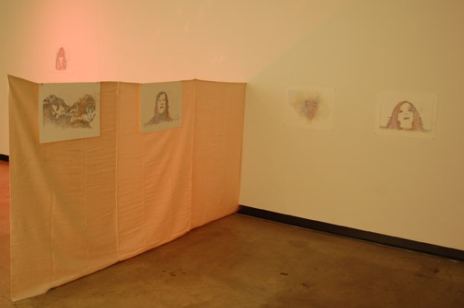 Her question is not, what is new? It's what can be stitched together and born again.
Her question is not, what is new? It's what can be stitched together and born again.See; not a hair is, not an eyelash, not the least lash lost; every hair | |
Is, hair of the head, numbered. (more) |
Including, Jason Hanasik, Untitled, Two Lemons, 2008
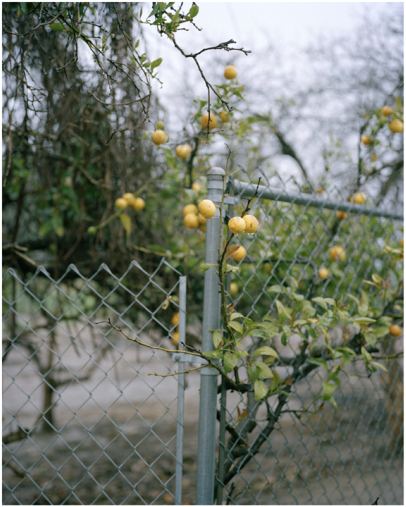
Leopards break into the temple and drink to the dregs what is in the sacrificial pitchers; this is repeated over and over again; finally it can be calculated in advance, and it becomes a part of the ceremony.In his review, Ken Johnson praised what he took to be Meade's refreshingly modest claims for the artists in his survey:
Fionn Meade, the show's organizer and the SculptureCenter's curator, says in an essay that he is under no illusions about which kind of cat he's wrangling. The artists he has picked, he writes, "return to distinct formal vocabularies and art historical trajectories," and they are intent on "borrowing and unsettling rather than wholesale attempts at either remaking or deconstructing." In other words, while working with familiar elements of style they mix and match their sources of inspiration in new but not shockingly novel ways.Meade's claims are only modest for those who still accept a modernist trajectory that peaks with destructive originals. Behind these tigers trail house-broken copycats, footnotes in someone else's story.
Mr. Meade is describing the essence of contemporary academicism, and while he puts a positive spin on this, it could be read as a devastating critique. These are not the bestial vandals so beloved by myth makers of the modern. It's rare for a curator to assess his artists in such honest terms, and in a sense Mr. Meade is operating in the gap between curator and critic. At a time when curators too often function more like smooth-talking hucksters than independent intellectuals, that is good and refreshing.
But what if the artists in Meade's show do not seek to despoil new frontiers but instead chose to acknowledge that the ground on which they stand is occupied? What if they want to make art out of an old ceremony rather than create a new one? What if their aim is not to shock but to unify? What if, in other words, they are not academics of old struggles but pioneers in new harmonies, ones with roots in the chaos of old scores?
Installation view, Leopards in the Temple:
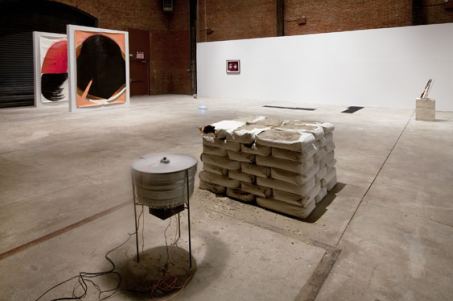 Meade comes from Seattle, where Ezra Pound's injunction to "Make it new" matters less than E. M. Forster's "Only connect."
Meade comes from Seattle, where Ezra Pound's injunction to "Make it new" matters less than E. M. Forster's "Only connect." The artist statement of an exhibit at Tacoma's now defunct Helm Gallery, Second Peoples, is worth quoting in full:
We have coined the name 'second peoples' to describe the people who arrive late on the scene, after the beginning, after the abundance, after the traumatic event, after everything's been said and done, after, even, the end. We are the second peoples. Chances are, you are too.Johnson again, about Meade's show:
This is an exhibition dealing with what it means to be second. We inhabit a landscape of iteration, reverb, elision, and generational noise. Our corner of North America-these mountains, that timber, this rich land-belonged to someone else. Our popular culture-those TV shows, that movie sequel, this new band that is so retro they're cool-belonged to some other time. Our art is that way, too: this gesture to Donald Judd, that nod to Philip Guston, that Eva Hesse wink.
We are interested in locating the coordinates of this second position. How did we end up here? What is our responsibility for what happened before us? What is our responsibility for the things that happen now in our names? Like Simone de Beauvoir argues in "Second Sex", we think we should be free to transcend ourselves as subjects, to not be confined to existential leftovers.
Contemporary art is concerned with this alchemy, trying to turn second-handedness into first-handedness, reversing the flow of energy, presenting not representing, creating value from valuelessness. We think this is a worthwhile activity. We also think it is a fraught activity. The work in this exhibition exposes some of the fractures created by this ceaseless turning, and also dreams of a third position, a reification of our desire to escape, a momentary place to stop.
No one here, however, is likely to topple the current regime of art, and in that respect these artists stand for the majority of contemporary strivers. They are resourceful, alert and eager to please, but are not wildly imaginative. Call them the mild ones.Note the verb topple. Artists need not make war on their predecessors to qualify as major. Back in the 14th Century, Chaucer cast tributes behind him: "Out of old fields comes all the new corn."
I was in the Haitian capital of Port-au-Prince, wandering at the edge of a marketplace as the sun went down. Whole swaths of the city are without electricity, government services or security. Things become spectral, as areas heavily trafficked and lively by day transform into deserted, nightmarish landscapes. I navigated for several miles using distant bonfires like homing devices.
Cite Soleil, 8 x 10 inches
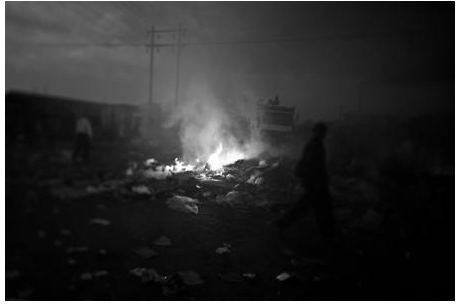 Antebi's photo-portrait of Haiti here. All proceeds from the sale of Cite Soleil go to Doctors Without Borders and OxFam, earmarked for Haiti. To purchase photo, email Wall Space Gallery at <mailto:gallery@
Antebi's photo-portrait of Haiti here. All proceeds from the sale of Cite Soleil go to Doctors Without Borders and OxFam, earmarked for Haiti. To purchase photo, email Wall Space Gallery at <mailto:gallery@Photo, Dean with Jesse at Jesse's wedding
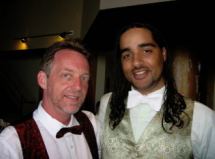 Some of you know this; some of you don't: My son Jesse, his wife Sarah and their young son Miles went to Port au Prince, Haiti, last Saturday and were there when the earthquake devastated the country (Sarah was there to do HIV trainings, part of her work with the University of Washington).
Some of you know this; some of you don't: My son Jesse, his wife Sarah and their young son Miles went to Port au Prince, Haiti, last Saturday and were there when the earthquake devastated the country (Sarah was there to do HIV trainings, part of her work with the University of Washington). Half of their hotel, the Hotel Creole, collapsed; the half they were staying in remained standing, and they are physically okay. Somewhat miraculously, Sarah had come home from work uncharacteristically early, five minutes before the quake hit, so they were all together.
In the hotel was a nurse, and because of this the Hotel Creole was turned into a kind of de facto hospital. For the past two days Jesse has been this man's deputy, first going through the hotel to strip sheets off of the beds and tear them into strips; then breaking apart furniture to use as splints; finally doing what the nurse told him to do, resetting broken bones, splinting, applying tourniquets, trying to stop bleeding and cleaning wounds. We were all relieved to learn the hotel had a supply of rubber gloves for Jesse and the Nurse to use as they worked on the stream of patients. Yesterday, despite what seemed a complete blackout of telephone and Internet connections, Jesse managed to find some unexplainable iPhone pathway through Miami and was able to call several of us; he said everything was awful, there was no medicine, no gauze, no hydrogen peroxide, no ibuprofen.
"Everywhere people are screaming, crying," he said. "People come up to me and say, 'Doctor, please help my child," and I say, 'I'm not a doctor, I don't speak Creole, and we don't have any medicine. I can't help you, I'm sorry." He told a story of a man who managed to get out of his house, but his son remained trapped. After a day, he managed to dig out his son and he brought the boy, with a head injury and a bone poking out of his leg, to the hotel because he had heard a nurse was there doing what could be done. Jesse wrapped the boy with the torn sheets, to staunch the bleeding and do what he could to straighten the leg and clean up the young boy's skull, "But then," Jesse said, "he died. We couldn't save him."
Continue reading Haiti - a note from a friend.
Gallerists drop artists too, most frequently because the artists prove unreliable. They miss exhibition dates and leave the dealer hanging, sell their work on the side in violation of an agreement or trash talk the dealer on a regular basis. If a dealer is found chained to a radiator after an S&M session that went badly, he won't look kindly on his own artists spreading the word.
Dealers may feel certain artists have failed to evolve. When Linda Farris found herself in the position of representing too many artists whom she felt had not delivered on their early promise, one of the top reasons she closed her gallery was to avoid cleaning house. She loved all the artists in her lineup but didn't necessarily love what their work had become.
Closing for that reason is rare. Also rare is for dealers to drop an artist for sales reasons if they continue to appreciate the product. Bruce Nauman sold badly until fairly recently. A dealer who let him go due to a paltry economic return (and I don't know of one) would be covered in shame. If dealers think a particular artist is top of the line, they hang in through the thin hoping to help create the thick.
On the other hand, if the artist's rise proves meteoric, the loyal dealer might well be dumped in favor of one who couldn't have cared less during the lean years. That's a painful payoff, intolerable in other business contexts, but gallerists are more than business people. They can never be great if they keep both eyes on the bottom line.
Enter the recession. Solid artists sell little or nothing. Trade that was once brisk has slowed to a trickle. Unless dealers have a trust fund or represent at least a couple of recession-proof cash cows, the price of mounting shows they couldn't have sold in flush times becomes more of a mental burden.
Case in point: Seattle gallerist James Harris recently dropped Glenn Rudolph. In terms of Northwest art, it's similar to a New York dealer dropping Nauman twenty years ago.
Rudolph is a poet of the post-apocalypse. He likes to photograph bad news once the news value has faded and people are making the best of their diminished circumstances. He favors those who live it up on the margins of society, in a bizarre social club (the Duct Tape Warriors in the Kent Valley), the artificial splendor of a suburban housing development (Kent, again) and his own neighborhood in North Seattle.
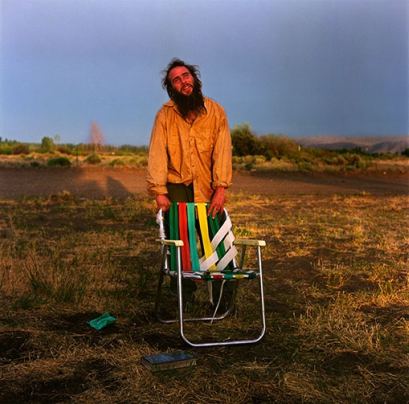
Continue reading Galleries look at their narrowing options.
Longing on a large scale is what makes history.Barnhart, at Ambach&Rice through Jan. 24.
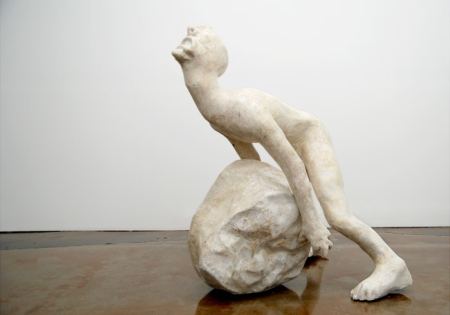
Nakamura, Filament Drawing, porcelain, DVD projection, 2010. The dark bulb is stage set for the electronic drawing, a line that advances, coils and disappears to reemerge for another try - let there be thin, fragile lines of experimental effort.
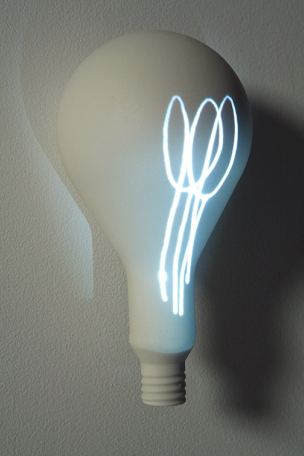 Light Bubbles (porcelain, plexiglas) depends upon conditions in the room, either projecting rabbit ear shadows or pooling its darks at each bulb's base. Her plexiglas bases evoke Robert Irwin's, but with more of a back story. Her bulbs are containers for the thing contained, our history from torch to gas to common glow.
Light Bubbles (porcelain, plexiglas) depends upon conditions in the room, either projecting rabbit ear shadows or pooling its darks at each bulb's base. Her plexiglas bases evoke Robert Irwin's, but with more of a back story. Her bulbs are containers for the thing contained, our history from torch to gas to common glow. 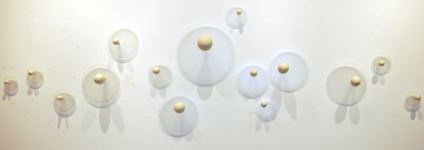
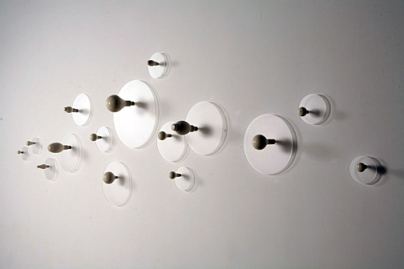 Nakamura is a kind of landscape artist, interested more in emblems than places, in maps that explore the meaning of the destination.
Nakamura is a kind of landscape artist, interested more in emblems than places, in maps that explore the meaning of the destination. At Howard House through Jan. 30.
(Cuban born painter) Juan Alonso wants to help out in Haiti but like a lot of us, he isn't in a position to donate a big wad of cash. Instead, he's donated a beautiful piece of his art called Sent. You have until Friday at noon to bid on it. Currently, the high bid is $550. All money raised goes to MercyCorps. More information here.Sent, 2005, color pencil on paper. 19" x 14" image / 33 ½" x 28 ½" framed

The beauty:
Dale Chihuly, glass ceiling, Victoria And Albert Museum
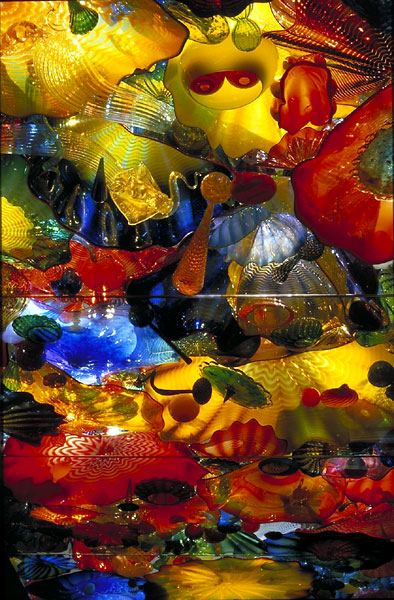 The beasts:
The beasts:Auroa Robson, from discarded plastic bottles, via
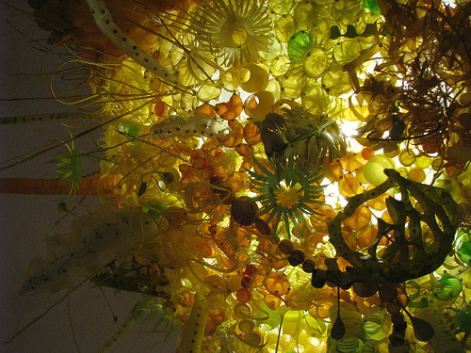 Judy Pfaff, made from whatever's at hand.
Judy Pfaff, made from whatever's at hand.
Continue reading Beauty and the beasts.
Even so, Bill Eppridge's outrage is understandable. (Via C-Monster)
Eppridge, Barstow to Vegas Motorcycle Race, 1971
 Seattle's Deborah Faye Lawrence, The Mysterious Allure of Rural America, 2008
Seattle's Deborah Faye Lawrence, The Mysterious Allure of Rural America, 2008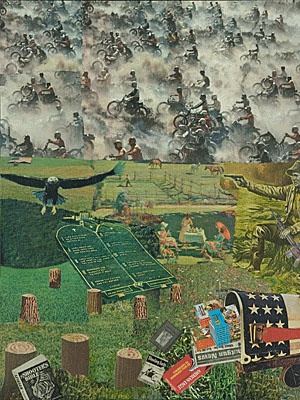 Undeniable, from Eppridge:
Undeniable, from Eppridge:The artist used my work to make her collaged work look better.Debatable:
I risked my life many times to make photographs -- in this case I was standing on the skid outside a helicopter at 500 feet. Seeing my work stolen in this manner just flat-out offends me because the artist used something that she didn't earn or create for her own benefit.That's cowboy logic. It's true that you can't rope a steer from your desk, but you can make powerful art without breaking a sweat.
Back to undeniable: Great image, Mr. Eppridge.
Whoever is left standing is the dream man, the American version of Mao. We celebrate not him but his parade-float iconography. No matter that cowboys worked long hours in menial jobs, like miners only in the open air and on horses. They're remembered as rugged individualists, not trigger-happy alcoholics.
Justin Colt Beckman is always willing to play once upon a time as long as he can mess with what follows the intro. In his photos and video at Punch Gallery, he impersonates the familiar in order to undermine its credibility. Although his square-jawed good looks tip us that he's the hero, when he goes for his gun, he does what TV cowboys never did - bungle the draw.
Sometimes he's fairly subtle. Striking a Roy Rogers/Dale Evans pose, he and his wife are so close to the real thing (the real TV thing) that memory collides with doubt. Who are these people? Don't we know them?
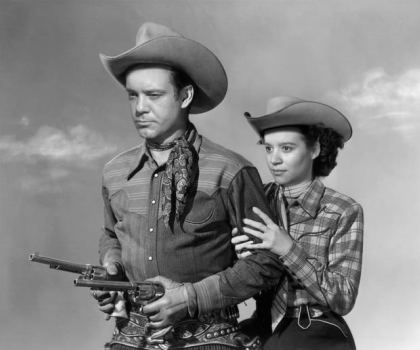 Beckman makes the commonplace rare. A bullet-ridden can? He painted it silver and serves it under glass.
Beckman makes the commonplace rare. A bullet-ridden can? He painted it silver and serves it under glass.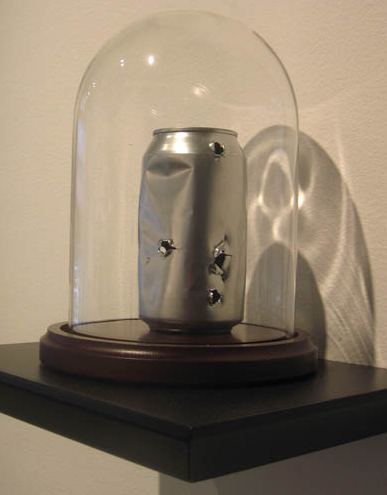 He's the man firing over his shoulder, the light on his white hat. But because he shot his face in shadow (like a bad guy) and the flesh of his hand flattened, as if it's pressed against the glass of the TV screen (screaming fake), he revels in his scam. In the heart of the he-man ideal, the hero cuts himself off from the past and charges blindly into the future, where he will, if the camera followed him, fade from view. Beckman's version doesn't ring entirely true, and that's what's good about it.
He's the man firing over his shoulder, the light on his white hat. But because he shot his face in shadow (like a bad guy) and the flesh of his hand flattened, as if it's pressed against the glass of the TV screen (screaming fake), he revels in his scam. In the heart of the he-man ideal, the hero cuts himself off from the past and charges blindly into the future, where he will, if the camera followed him, fade from view. Beckman's version doesn't ring entirely true, and that's what's good about it. 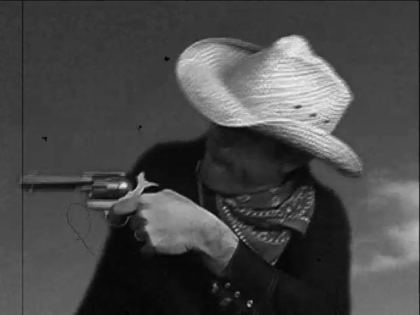 Through Jan. 30.
Through Jan. 30.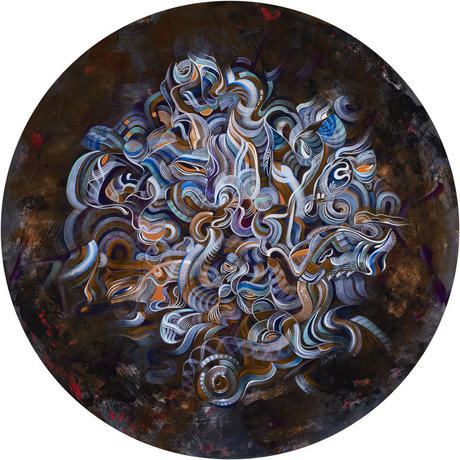 Eva Speer - flowers that rot on your wrist. An accessory for the prom in hell.
Eva Speer - flowers that rot on your wrist. An accessory for the prom in hell.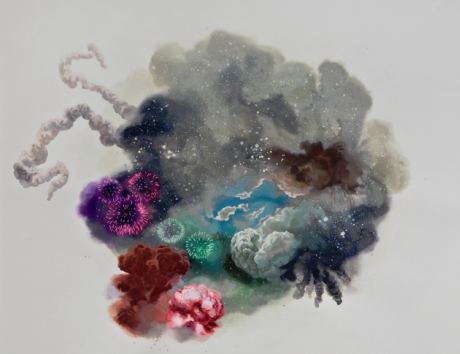
From his papers, a new portion of which was released Monday: (Story via)
In a Jan. 26, 1970, memo to Haldeman and secretary Rose Mary Woods, the president demanded that the administration ''turn away from the policy of forcing our embassies abroad or those who receive assistance from the United States at home to move in the direction of off-beat art, music and literature.''If Macbeth and his wife were one person, Nixon would be him. Reagan was an empty suit, and Bush is too stupid for tragedy. He caused tragedies but could not embody them. The last Republican who was worthy of his part in the play is long dead, but his papers will continue to tantalize.
He called the Lincoln Center in New York a ''horrible monstrosity'' that shows ''how decadent the modern art and architecture have become,'' and declared modern art in embassies ''incredibly atrocious.'' ''This is what the Kennedy-Shriver crowd believed in and they had every right to encourage this kind of stuff when they were in,'' he wrote. ''But I have no intention whatever of continuing to encourage it now. If this forces a show-down and even some resignations it's all right with me.''
More than Nixon's artistic sensibilities were at play here. He made the political calculation that ''those who are on the modern art and music kick are 95 percent against us anyway.''
Philip Guston, via
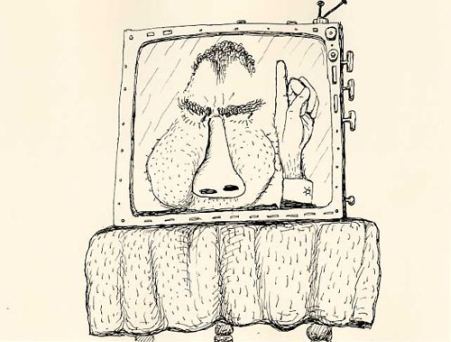
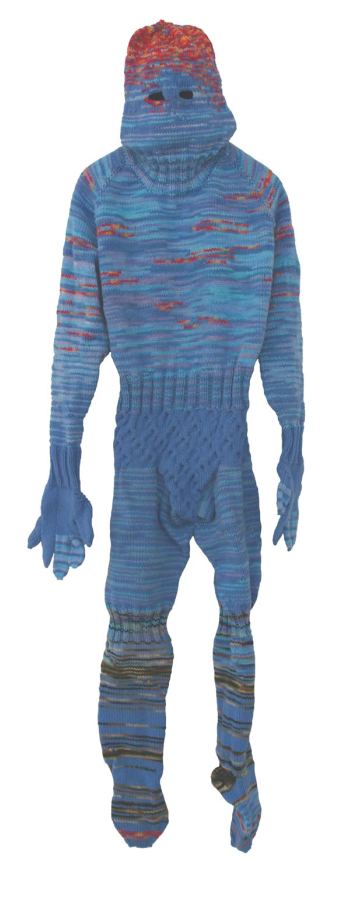 The artist looks like a mild-mannered nerd, which is why the photos of him knitting his way through his superhero fantasies are compelling.
The artist looks like a mild-mannered nerd, which is why the photos of him knitting his way through his superhero fantasies are compelling.Alter Egos: At the Game
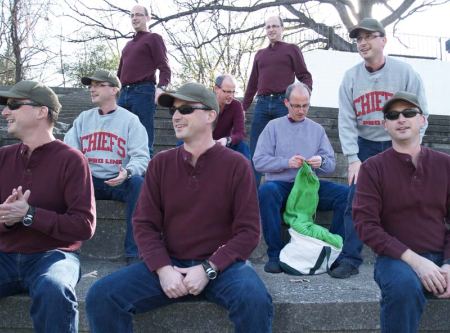 Just dreaming of them works too.
Just dreaming of them works too.Alter Egos: Cowboy
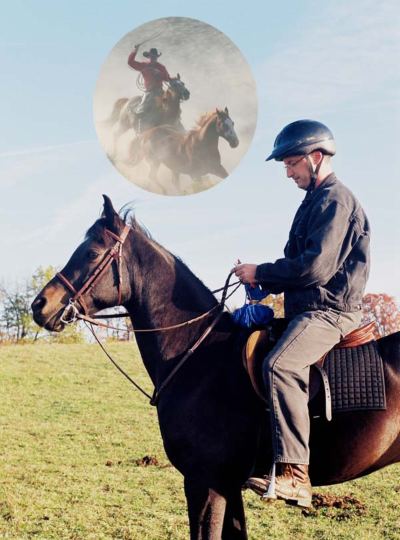 Through Feb. 13.
Through Feb. 13.Thank you, journalism. After this story hit the NYT and began to bounce around on blogs and facebook, these corporations changed course. They now say they'll donate to charities what they haven't sold.
The situation is different for artists. Those who discard drawings in recycling dumpsters have found them again for sale or framed in some collector's home. It's necessary for artists to cut up what they want to destroy or it might live again, the art that they have every right to edit out.
And cutting up clothes doesn't mean the same thing in fashion as it does to Wal-Mart.
Viktor & Rolf (image via Amy Goodwin)
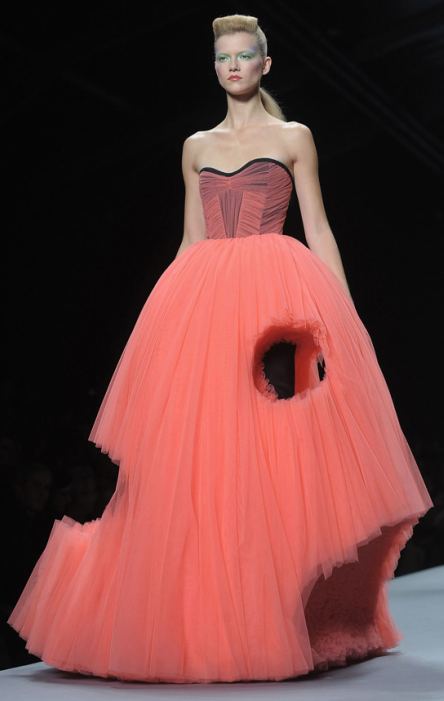
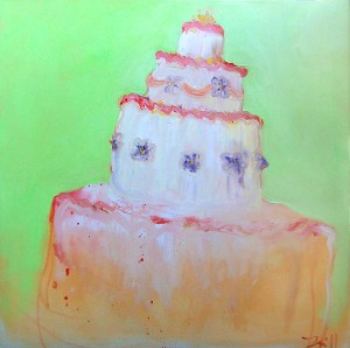 Anya Gallaccio - Nothing lasts. From frosting topping to symbols of the sacred.
Anya Gallaccio - Nothing lasts. From frosting topping to symbols of the sacred.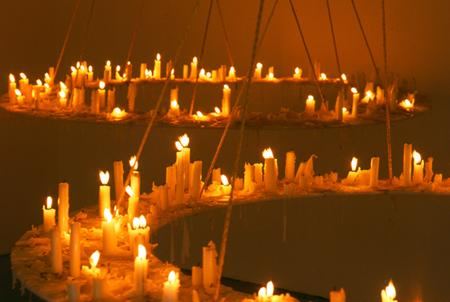
Here's Seattle novelist Jonathan Evison on an artist's life, via Harold Hollingsworth. They both identify with the Charlie Kaufman line from Adaptation, "You are what you love, not what loves you."
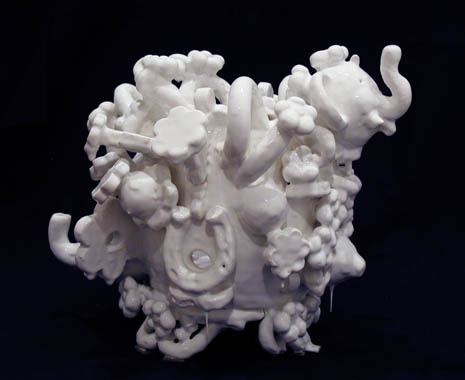 Hollingsworth in 1967:
Hollingsworth in 1967: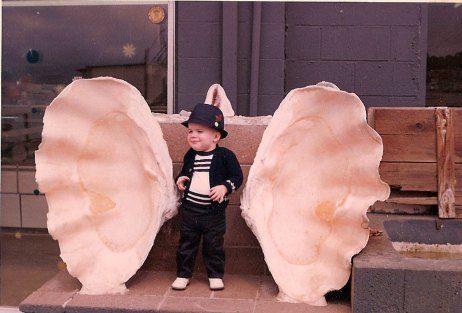 He still wears that hat or one suspiciously like it. What he does today, image via.
He still wears that hat or one suspiciously like it. What he does today, image via.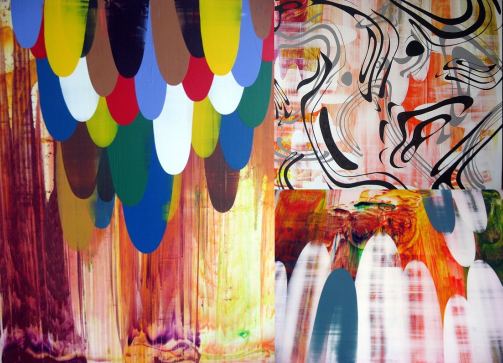
I'm quite sure I could beat LeBron James in a game of one on one basketball. The game merely needs to feature two special rules: It lasts until I score, and as soon as I score I win. Such a game might last several hours, or even a week or two, and James would probably score hundreds and possibly thousands of points before my ultimate victory, but eventually I'm going to find a way to put the ball in the basket.Heide Hinrichs, from The Expected Obedience of Your Thoughts
Our national government and almost all of the establishment media have decided to play a similar game, which could be called Terrorball. The first two rules of Terrorball are:
(1) The game lasts until there are no longer any terrorists, and;
(2) If terrorists manage to ever kill or injure or seriously frighten any Americans, they win.
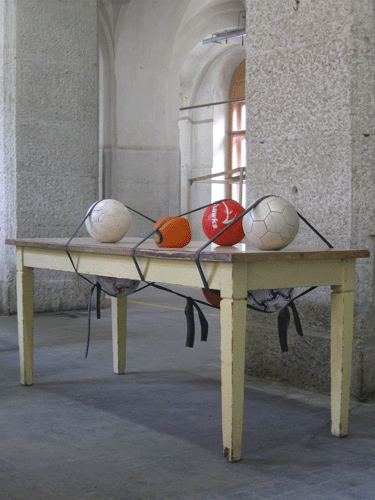 Campos continued:
Campos continued:The typical Congressional subcommittee chairman or cable news anchor or syndicated columnist can't really imagine not being able to afford to take his child to a doctor, or being wrongly convicted of a crime, but he is quite capable of imagining being on a Paris to New York flight that's blown out of the sky. And while it's true the risk he faces of suffering this fate are very close to zero, they are not, as they are for a poor person, literally zero.
Kris Martin, Mandi VIII (Note the absence of the snakes, and yet the figures writhe.)
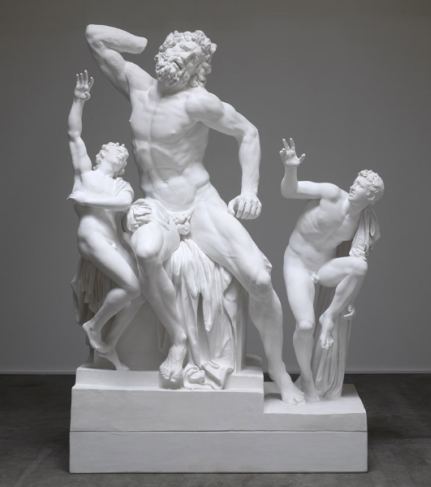 Campos:
Campos:Terrorball, then, is an elaborate political game that seems irrational on its face - after all, it's certain that more than 2.4 million Americans will die this year, and fairly likely that not even one of those deaths will be caused by terrorism -- but which features its own peculiar logic. That logic reflects the anxieties of those who have created its rules, and serves the interests of both terrorists and those who profit from exploiting the fear of terrorism.And now this, via:
In other words, dozens of Yemeni men are going to continue their prison stay not because of what they have done but because there is a threat that someone in their number might do something in the future, inflamed, no doubt, by being detained by us without trial and tortured for years.
U.S. President Barack Obama has announced he would suspend the transfer of Guantánamo prisoners to Yemen, where an Al Qaeda-linked group is said to have planned a failed attack on a U.S. airliner. Around half the 198 remaining Guantánamo prisoners are Yemeni nationals and, according to the latest data available, less than 40 have already been cleared for release. In a statement, the Center for Constitutional Rights said: "Dozens of men from Yemen who have been cleared for release after extensive [government] scrutiny are about to be left in limbo once more due to politics, not facts. Halting [their] repatriation is unconscionable."
Lacking evidence to bring them to trial, we must release them, no matter how unsavory their future actions. If we imprison people for crimes they may commit, we have become what we fear. This is not what "Yes We Can" was supposed to mean.
Look around the world baby it can't be denied
Why are we always on the wrong side. (via)
Selma Waldman
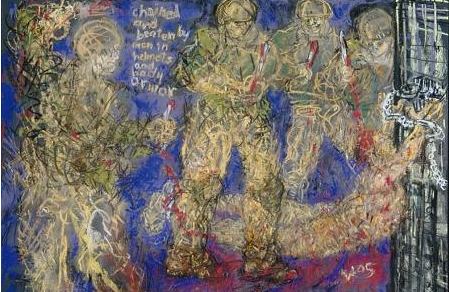 Leon Golub
Leon Golub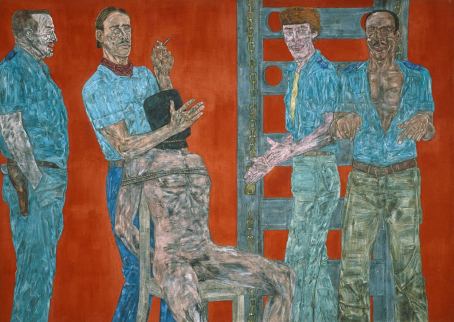 Nancy Spero
Nancy Spero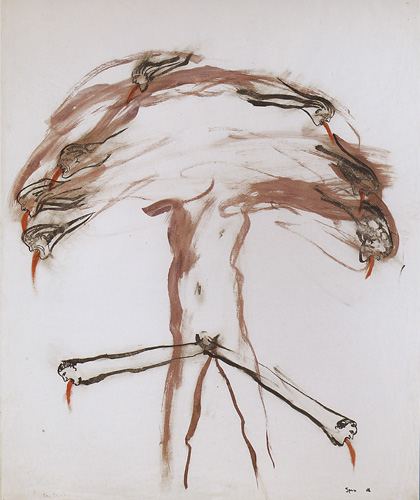 Michael Spafford
Michael Spafford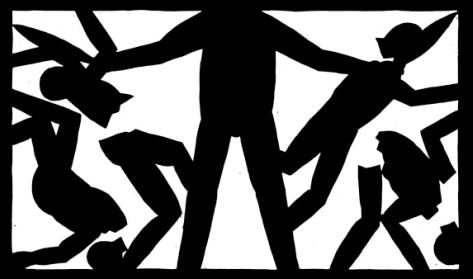 Jack Daws
Jack Daws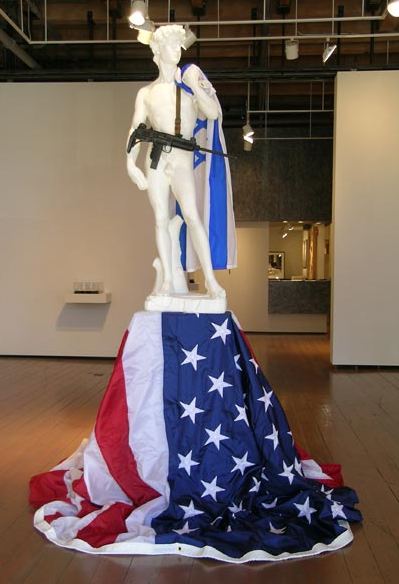
For the appetizer: San Antonio Bay oysters polluted with Noroviruses. For the main course: grilled beef infected with E. coli from contaminated tenderizing needles; chicken with Campylobacter or imported ham with Listeria monocytogenes. Then there's a side dish of stuffing loaded with salmonella-contaminated hazelnuts. And for those watching their weight: a popular nutritional drink fouled with the food poison Bacillus cereus.Carrie Schneider
Even the family pet wasn't forgotten. Its pigs ears and beef hooves were laced with salmonella. All those item were recalled in December by the federal government or were the subjects of warnings by food safety experts.
And 2010 isn't shaping up to set a safer table, according to some of the country's leading food safety experts. (more)
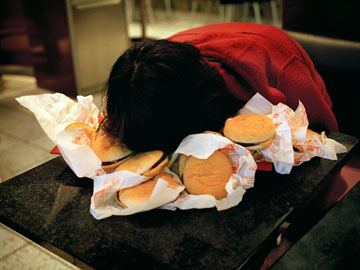 Happy New Year!
Happy New Year!Some/One has been up so long at SAM, and in such a prominent way, that its impact has faded for me. But it is a majestic work, and by a terrific artist; I love his silken architectures, houses and structures that hang in the air, memories. (more)Made of 100,000 dog tags that sweep the floor to rise to a hero's armor, Some/One is a salute to the soldiers whose deaths become a monument to the man in charge. Seen from the front, the gown is an empty cavity whose inside is covered in cheap reflective material, giving viewers the dubious honor of seeing themselves as the One in the title surrounded by the Some.
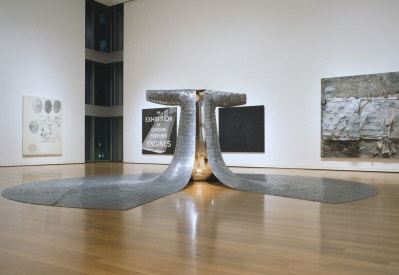 There are music critics who call for a moratorium on Mozart. They've had enough, forgetting that for each generation, he is new, and new to those who know him already as they hear him again at different stages of their lives. But music critics are in concert halls all the time. The music holds up, but they wear down.
There are music critics who call for a moratorium on Mozart. They've had enough, forgetting that for each generation, he is new, and new to those who know him already as they hear him again at different stages of their lives. But music critics are in concert halls all the time. The music holds up, but they wear down.At least music critics are forced to sit in their seats and listen. Art critics, hurrying from gallery to gallery, museum to museum, respond to art that stops them in their tracks, art that, in Peter Brooks' phrase, pulls them up by their own hair and turns them inside out. The next time they see that piece, they want the same high, the flush of the first time.
There's the pleasure of encountering a significant form and the joy of its reverberations, figuring out its relationships and meanings in its context.
Tim Appelo:
Sometimes the only cure for boredom is to look harder.Nice essay by Appelo, but his solution is wide of the mark. The problem is not lack of work. Critics seeking to reengage their original reactions have already done the work. The thrill of that effort is gone. They've moved from being on a hot date to being with an old friend. The bedrock of any critic's experience is old friends. As Graves is brave enough to note, it can be difficult to keep old friends from boring us.
At the Henry, Jan. 15, 7-8:15 p.m. Preview below.
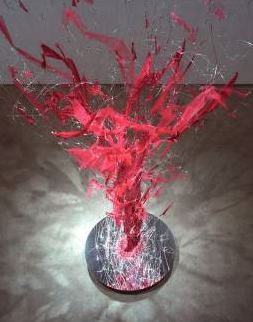 Turns out, that's what brain neurons look like at any given moment. (From Wired, via)
Turns out, that's what brain neurons look like at any given moment. (From Wired, via) Gerard Manley Hopkins:
Gerard Manley Hopkins:
- O the mind, mind has mountains; cliffs of fall
- Frightful, sheer, no-man-fathomed. Hold them cheap
- May who ne'er hung there.
Seattle painter Ken Kelly needed emergency brain surgery, which he was lucky enough to obtain. Now he has the bill, which is large. He is uninsured.
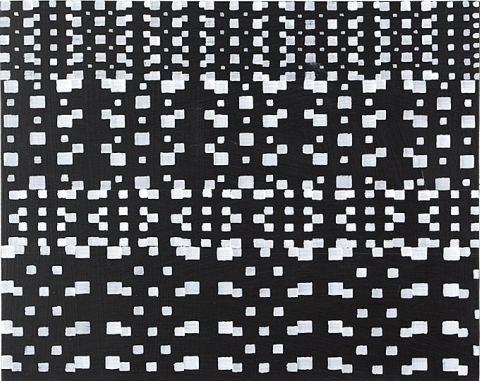 Were he a European, his friends could limit their involvement to a card, an email, a texted well-wish, a hug or a flower or two. Because he's an American, they need to do more. In an event that is surely repeated for other artists many times around the country, Kelly's friends are organizing a fund-raising art auction for him on Jan. 23, 7 p.m. at Lemon Lime Studio, 411 Yale Ave. N., two blocks north of REI.
Were he a European, his friends could limit their involvement to a card, an email, a texted well-wish, a hug or a flower or two. Because he's an American, they need to do more. In an event that is surely repeated for other artists many times around the country, Kelly's friends are organizing a fund-raising art auction for him on Jan. 23, 7 p.m. at Lemon Lime Studio, 411 Yale Ave. N., two blocks north of REI.(1/7 Update from Kelly: "As you can see, the brain surgery caused complications...")
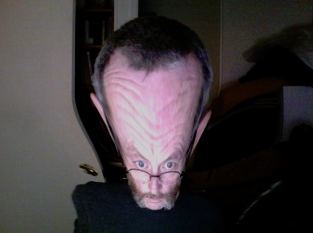
Continue reading Uninsured artist - the usual story.
Opening at LP Thursday night, 6-9, are Caleb Larsen's Everything All of the Time Right Now plus Wet And Leatherhard, a group exhibit focused on ceramics curated by Susie J. Lee. The latter features Sterling Ruby, Jim Melchert, Kristen Morgin, Wynne Greenwood, Ben Waterman, Meiro Koizumi, Doug Jeck and Tim Roda.
From Larsen, the $10,000 sculpture, in progress. It accepts your dollar bills and gives you nothing back.

The artist's artwork and design enhancements will be incorporated during construction of the streetcar line. The design should include reproducible or repeating elements and components that contribute to the overall identity of the streetcar. (more)Sounds like a branding opportunity, more ad than art. There are artists who can make something substantial from these dim prospects, but why are they so dim? Must public art be yes-man to public projects? The problem is, no one is dreaming of baboons and periwinkles.
Wallace Stevens
Disillusionment of Ten O'Clock
The houses are haunted
By white night-gowns.
None are green,
Or purple with green rings,
Or green with yellow rings,
Or yellow with blue rings.
None of them are strange,
With socks of lace
And beaded ceintures.
People are not going
To dream of baboons and periwinkles.
Only, here and there, an old sailor,
Drunk and asleep in his boots,
Catches Tigers In red weather.
They are David Wesley Black - guerrilla letterpress; Joe Kent & Sallyann Corn - reduce, reuse, restraint a return to normalcy; designer Michael Taylor - 30 going on 8; Valerie Farber - designer / musicians of stories past and present; Jenny Fillius - recycled tin artist; Ann Wolf - Old! New! Old! NEW!; Animish Kudalkar - MUNDANE mass; Brianna Holan - music and fashion from the eye of an urbanist; Kristen Young - blank canvas; Todd Waffner - 1000 years of evolution continues in a 21st century sailboat, and Deborah Faye Lawrence - recycler of political propaganda and pop imagery .
Deborah Faye Lawrence, The Mysterious Allure of Rural America, 2008
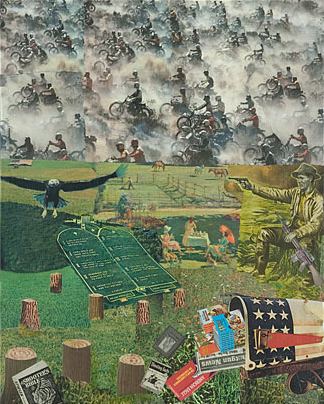
January 6, 2010 9:41 AM
| Permalink
|
If buying art is a habit, many have broken it. The formerly flush will have extra money again, but when will their hearts swell with acquisitive desire? The kind of collectors who are capable of turning the tide (and encouraging others to join them) are motivated not just by the pleasure of owning one more piece but by standing by the artists whose work matters most in their lives as well as stretching to interact with the new.
In hopes that their artists can provide those experiences, Seattle galleries are looking to come on strong in January.
The top of the list:
Gretchen Bennett and Yuki Nakamura at Howard House.
Bennett: The excellent text for both artists produced by the gallery.
Gretchen Bennett's show, Community World Theater, takes its name from an old movie theater turned punk venue in Tacoma, Washington, the site of about three dozen shows in 1987 and 1988. Bennett's work of the last two years has explored Kurt Cobain as a sort of a natural event--an eruption or a cultural moment as relevant as the first step on the moon. In her new work, Mary Shelley's Frankenstein and the atmospheric paintings of JMW Turner serve as a conceptual basis for this continued exploration, both for their subject matter and for their connection to 1816, a year of significant climatic abnormalities due in part to the historic eruption of Mount Tambora.
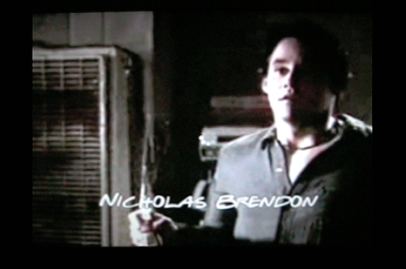 Nakamura:
Nakamura:Yuki Nakamura's porcelain light bulbs, cast in antique and contemporary forms, are ruminations on light, beauty, and the history of invention and obsolescence. Thomas Edison unveiled his carbon filament bulb 130 years ago, but today this classic design is quickly disappearing, replaced by more energy efficient models. Nakamura's evocative installations create a new landscape of an electric world. Transformed into porcelain skins and animated projections of filaments, her light bulbs are a investigation of texture, shape, and volume as well as the contrast between the bulb's surface the exterior light source.
 Justin Colt Beckman at Punch. Beckman blurs the distinction between cowboys, hillbillies and rednecks, all of them aspects of his rugged person. O give me a home, where he-man images roam....
Justin Colt Beckman at Punch. Beckman blurs the distinction between cowboys, hillbillies and rednecks, all of them aspects of his rugged person. O give me a home, where he-man images roam....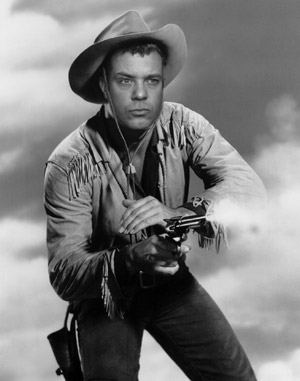 Mark Newport and John Buck at Greg Kucera.
Mark Newport and John Buck at Greg Kucera.Newport continues to knit his way through the sagging fortunes of low-rent superheroes.
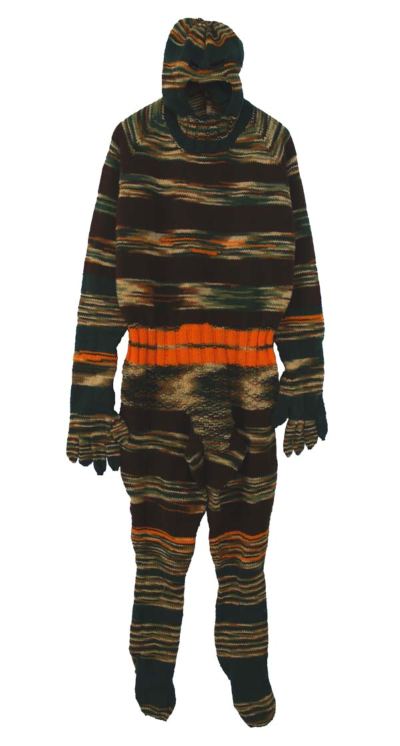 Buck continues to carve his own picture dictionary of people, places and things. (Below, detail.)
Buck continues to carve his own picture dictionary of people, places and things. (Below, detail.)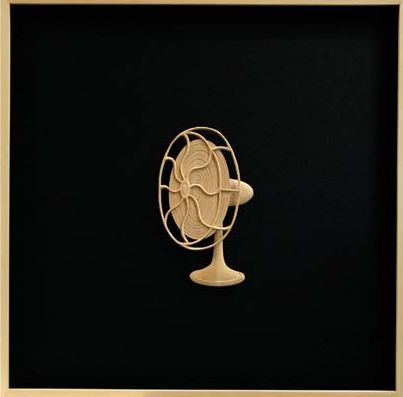 Amir Zaki and Ron Nagle at James Harris.
Amir Zaki and Ron Nagle at James Harris.Zaki's recent focus is the color-saturated purity of life-guard stations. They're very L.A. and very pertinent to our present situation. Save us, we cry. Nobody's there.
 After half a century, everything Ron Nagle does is new. No false moves for this wily old clay master.
After half a century, everything Ron Nagle does is new. No false moves for this wily old clay master.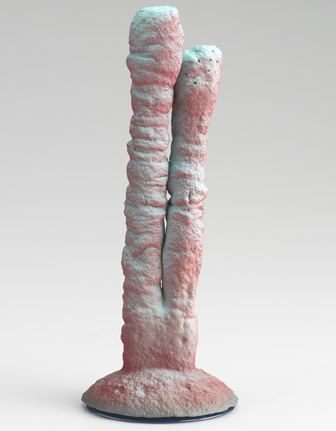 Michael Brophy at G. Gibson. The painter from Portland wants to be alone.
Michael Brophy at G. Gibson. The painter from Portland wants to be alone.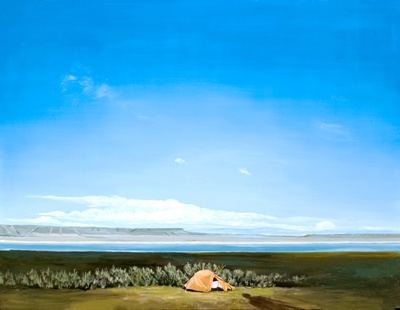 Marc Dombrosky at Platform.
Marc Dombrosky at Platform.Michael Jackson died on the day that I both started and lost my job in Las Vegas.
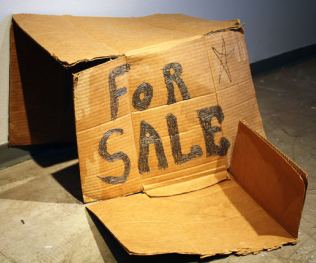
(See update: Lawrimore Project opening needs to be in the lead list.)
Also:
Early Work by Selma Waldman, 1960-65, Thursday, 4 p.m.-10 p.m., 619 Western Ave., 6th floor, north studios.... Juan Alonso's last open studio, Thursday, 6-9 p.m., Grand Central Arcade, 214 1st Ave. S. ...A to Z: New Members Show (Iole Alessandrini, Julie Alpert, and Ellen Ziegler) at Soil, with Nicholas Nyland in the back space....Jessica Drenk and Patrick Kelley at Catherine Person...Four Views: Painters Margaretha Bootsma, Jack Chevalier, Gayle Bard and Brenna Helm at Linda Hodges.
Worth remembering: Everybody involved in art chose it. Nobody was forced into laboring in the art mine. While it can be heart-breaking, especially for artists, art offers the best jobs in the world. Every day there's a chance to be alert, awake and aware; engaged, engrossed and rising to the occasion. (More in necessary optimism from Ed Winkleman.)
Also:
Early Work by Selma Waldman, 1960-65, Thursday, 4 p.m.-10 p.m., 619 Western Ave., 6th floor, north studios.... Juan Alonso's last open studio, Thursday, 6-9 p.m., Grand Central Arcade, 214 1st Ave. S. ...A to Z: New Members Show (Iole Alessandrini, Julie Alpert, and Ellen Ziegler) at Soil, with Nicholas Nyland in the back space....Jessica Drenk and Patrick Kelley at Catherine Person...Four Views: Painters Margaretha Bootsma, Jack Chevalier, Gayle Bard and Brenna Helm at Linda Hodges.
Worth remembering: Everybody involved in art chose it. Nobody was forced into laboring in the art mine. While it can be heart-breaking, especially for artists, art offers the best jobs in the world. Every day there's a chance to be alert, awake and aware; engaged, engrossed and rising to the occasion. (More in necessary optimism from Ed Winkleman.)

I don't want to sell anything, buy anything, or process anything as a career. I don't want to sell anything bought or processed, or buy anything sold or processed, or process anything sold, bought, or processed, or repair anything sold, bought, or processed. You know, as a career, I don't want to do that.
Robert Francis Zvernia as himself, from email sent, 2010:
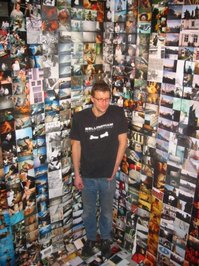
I guess I'm what you'd call a new media artist. I work primarily in digital photography and video and have been distributing my work online since 1997. I'm no Luddite but I am concerned about the inclusion of cell phone art and the like as appropriate media for submission in the below call for public art proposals. Here's why: Public art by definition should be free and accessible to all. Cell phone art and the like violate this basic principle by requiring the purchase of equipment and/or services from commercial interests in order to access the nominally public work. While the incorporation of fee-attached technologies may be acceptable in private settings, any work which is publicly funded and located should be self-contained and present no financial barriers to its appreciation. I hope you will keep this in mind as you fulfill your roles as stewards of the public trust.Zverina takes issue with a call for proposals from Seattle's Office of Arts & Cultural Affairs:
In collaboration with Seattle Parks and Recreation and the Seattle Department of Transportation (SDOT), Seattle's Office of Arts & Cultural Affairs seeks an artist to create a new media artwork for the Cheshiahud Lake Union Loop. The Cheshiahud Lake Union Loop is a pedestrian trail that surrounds Lake Union in Seattle. The selected artist will create a new media project drawing on the history and/or context of the site. Possible media include podcast- or cell-phone based audio work, audio and/or video tours using mobile media and GPS, and walking tours or interactive events using the Web.
Eligibility: Open to professional artists living in Washington, Oregon, Idaho, Montana, British Columbia and California. Budget: $18,000 all-inclusive Deadline: 11 p.m., Tuesday, Jan. 12, 2010 (Pacific Time) Details here.
Related:
Before AbEx, abstraction was reductive. A
The dead-battery-torch-song theory has only one flaw: It isn't true. AbEx's powerful progeny are everywhere, doing their bit for overall fields and the pleasures of push/pull, but the ones who rise to prominence refer to their family tree at their peril.
Here are a few:
Joan Snyder
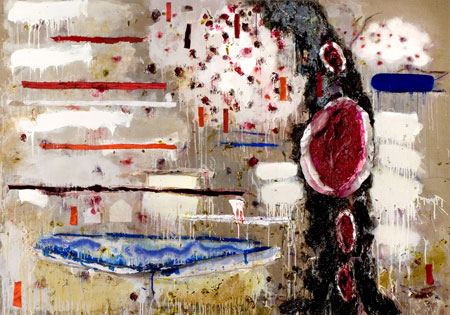 Susan Rothenberg (Image via)
Susan Rothenberg (Image via)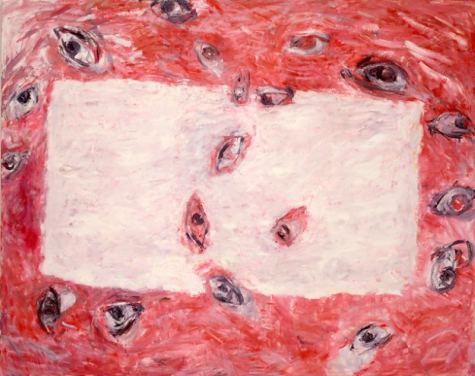 Robert C. Jones
Robert C. Jones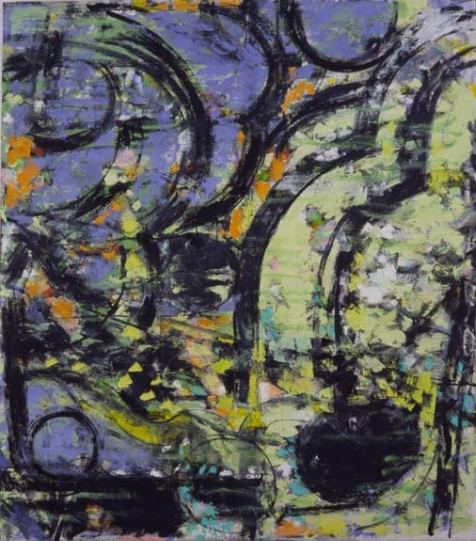 Lauri Chambers
Lauri Chambers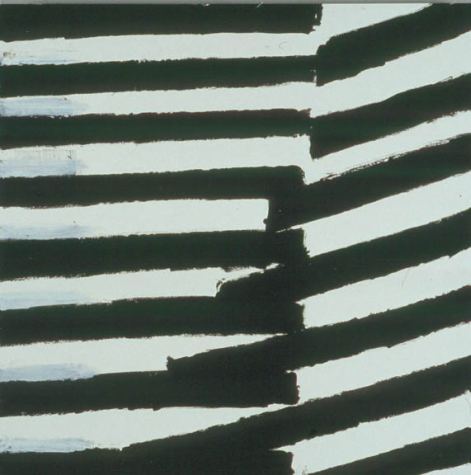
Alden Mason
 Denzil Hurley
Denzil Hurley Jacqueline Barnett
Jacqueline Barnett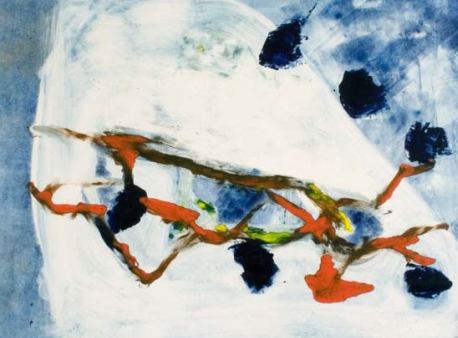 Mark Takamichi Miller (At Howard House)
Mark Takamichi Miller (At Howard House)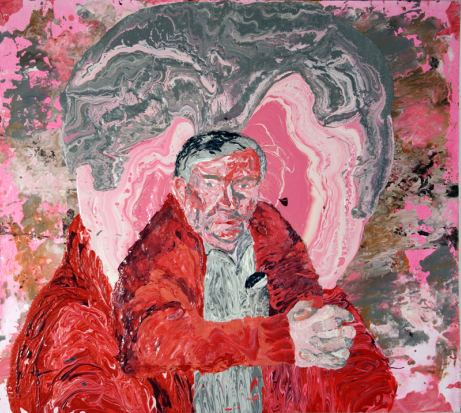
In spite of the categories into which others try to tidy them away, artists continue. Why? Virginia Woolf attempted an answer in the person of Lily Briscoe, a painter of little or no prominence in To The Lighthouse.
Lily stepped back to get her canvas - so - into perspective. It was an odd road to be walking, this of painting. Out and out one went, further and further, until at last one seemed to be on a narrow plank, perfectly alone, over the sea.Chester Arnold, Inventory, 2005, 22 x 26, oil/linen
...
Why then did she do it? She looked at the canvas, lightly scored with running lines. It would be hung in the servants' bedrooms. It would be rolled up and stuffed under a sofa. What was the good of doing it then, and she heard some voice saying she couldn't paint, saying she couldn't create, as if she were caught up in one of those habitual currents in which after a certain time experience forms in the mind, so that one repeats words without being aware any longer of who originally spoke them.
Can't paint, can't write, she murmured monotonously, anxiously considering what her plan of attack should be. For the mass loomed before her; it protruded; she felt it pressing on her eyeballs. Then, as if some juice necessary for the lubrication of her faculties were spontaneously squirted, she began precariously dipping among the blues and umbers, moving her brush hither and thither, but it was now heavier and went slow, as if it had fallen in with some rhythm which was dictated to her (she kept looking at the hedge, at the canvas) by what she saw, so that while her hand quivered with life, this rhythm was strong enough to bear her along with it on its current. Certainly she was losing consciousness of outer things. And as she lost consciousness of outer things, and her name and her personality and her appearance, and whether Mr. Carmichael was there or not, her mind kept throwing up from its depths, scenes, and names and sayings, and memories and ideas, like a fountain spurting over that glaring, hideously difficult white space, while she modeled it with greens and blues.
...
Quickly, as if she were recalled by something over there, she turned to her canvas. There it was - her picture. Yes, with all its greens and blues, its lines running up and across, its attempt at something. It would be hung in the attics, she thought; it would be destroyed. But what did that matter? she asked herself, taking up her brush again. She looked at the steps; they were empty; she looked at her canvas; it was blurred. With a sudden intensity, as if she saw it clear for a second, she drew a line there, in the centre. It was done; it was finished. Yes, she thought, laying down her brush in extreme fatigue, I have had my vision.
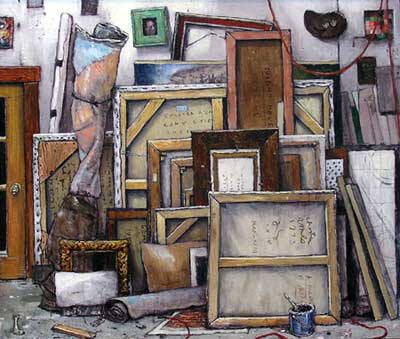
About
Blogroll
AJ Blogs
AJBlogCentral | rssculture
About Last Night
Terry Teachout on the arts in New York City
Terry Teachout on the arts in New York City
Artful Manager
Andrew Taylor on the business of arts & culture
Andrew Taylor on the business of arts & culture
blog riley
rock culture approximately
rock culture approximately
critical difference
Laura Collins-Hughes on arts, culture and coverage
Laura Collins-Hughes on arts, culture and coverage
Dewey21C
Richard Kessler on arts education
Richard Kessler on arts education
diacritical
Douglas McLennan's blog
Douglas McLennan's blog
Dog Days
Dalouge Smith advocates for the Arts
Dalouge Smith advocates for the Arts
Flyover
Art from the American Outback
Art from the American Outback
lies like truth
Chloe Veltman on how culture will save the world
Chloe Veltman on how culture will save the world
Life's a Pitch
For immediate release: the arts are marketable
For immediate release: the arts are marketable
Mind the Gap
No genre is the new genre
No genre is the new genre
Performance Monkey
David Jays on theatre and dance
David Jays on theatre and dance
Plain English
Paul Levy measures the Angles
Paul Levy measures the Angles
Real Clear Arts
Judith H. Dobrzynski on Culture
Judith H. Dobrzynski on Culture
Rockwell Matters
John Rockwell on the arts
John Rockwell on the arts
State of the Art
innovations and impediments in not-for-profit arts
innovations and impediments in not-for-profit arts
Straight Up |
Jan Herman - arts, media & culture with 'tude
Jan Herman - arts, media & culture with 'tude
dance
Foot in Mouth
Apollinaire Scherr talks about dance
Apollinaire Scherr talks about dance
Seeing Things
Tobi Tobias on dance et al...
Tobi Tobias on dance et al...
jazz
Jazz Beyond Jazz
Howard Mandel's freelance Urban Improvisation
Howard Mandel's freelance Urban Improvisation
ListenGood
Focus on New Orleans. Jazz and Other Sounds
Focus on New Orleans. Jazz and Other Sounds
Rifftides
Doug Ramsey on Jazz and other matters...
Doug Ramsey on Jazz and other matters...
media
Out There
Jeff Weinstein's Cultural Mixology
Jeff Weinstein's Cultural Mixology
Serious Popcorn
Martha Bayles on Film...
Martha Bayles on Film...
classical music
Creative Destruction
Fresh ideas on building arts communities
Fresh ideas on building arts communities
The Future of Classical Music?
Greg Sandow performs a book-in-progress
Greg Sandow performs a book-in-progress
Overflow
Harvey Sachs on music, and various digressions
Harvey Sachs on music, and various digressions
PianoMorphosis
Bruce Brubaker on all things Piano
Bruce Brubaker on all things Piano
PostClassic
Kyle Gann on music after the fact
Kyle Gann on music after the fact
Sandow
Greg Sandow on the future of Classical Music
Greg Sandow on the future of Classical Music
Slipped Disc
Norman Lebrecht on Shifting Sound Worlds
Norman Lebrecht on Shifting Sound Worlds
The Unanswered Question
Joe Horowitz on music
Joe Horowitz on music
publishing
book/daddy
Jerome Weeks on Books
Jerome Weeks on Books
Quick Study
Scott McLemee on books, ideas & trash-culture ephemera
Scott McLemee on books, ideas & trash-culture ephemera
theatre
Drama Queen
Wendy Rosenfield: covering drama, onstage and off
Wendy Rosenfield: covering drama, onstage and off
visual
Aesthetic Grounds
Public Art, Public Space
Public Art, Public Space
Another Bouncing Ball
Regina Hackett takes her Art To Go
Regina Hackett takes her Art To Go
Artopia
John Perreault's art diary
John Perreault's art diary
CultureGrrl
Lee Rosenbaum's Cultural Commentary
Lee Rosenbaum's Cultural Commentary
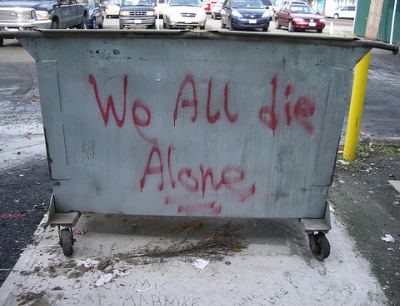
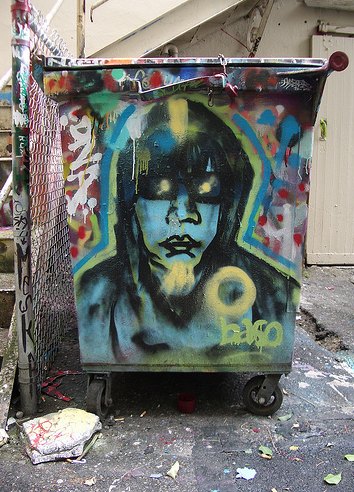
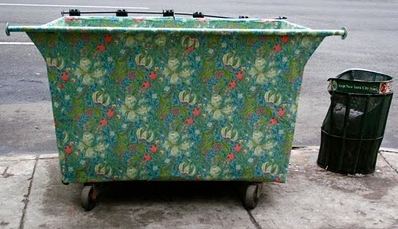
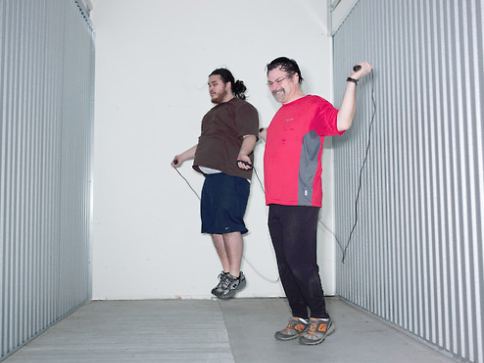
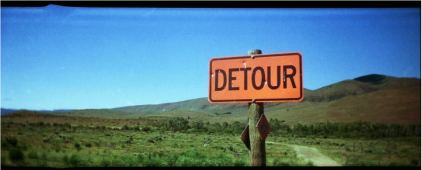
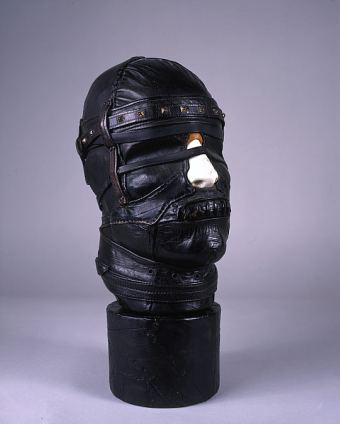
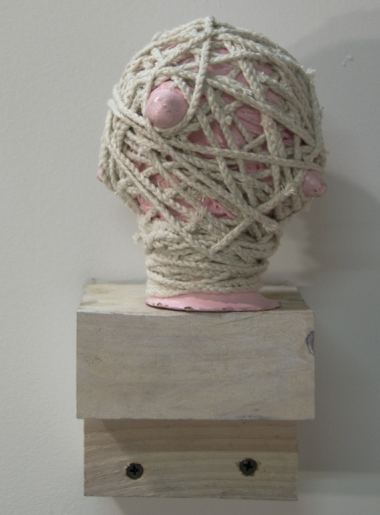 First tragedy, then Elmer Fudd.
First tragedy, then Elmer Fudd. 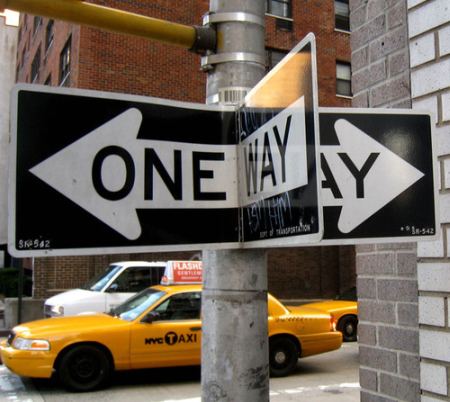
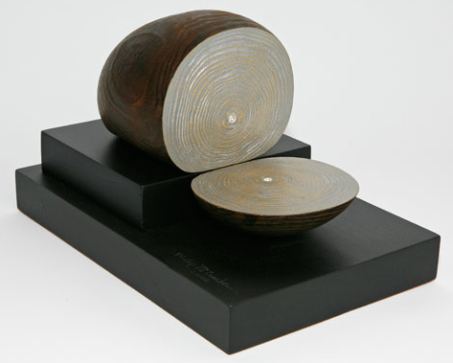
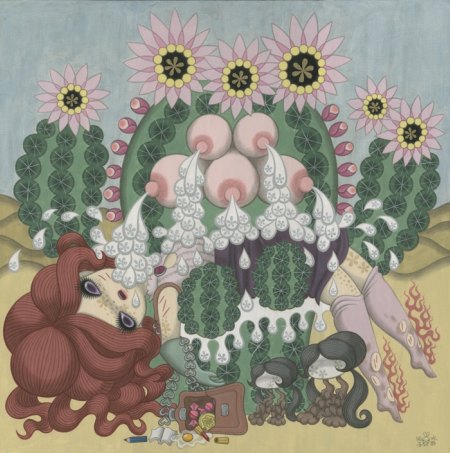
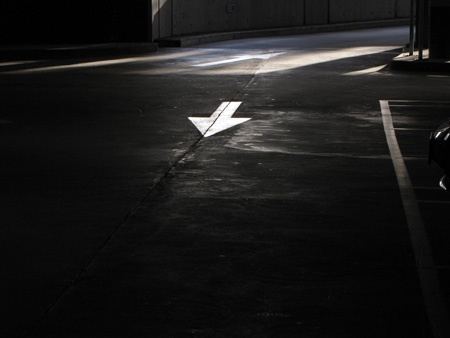





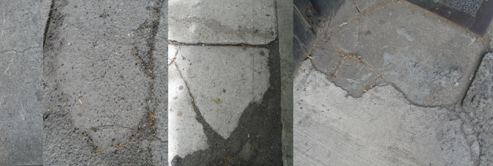
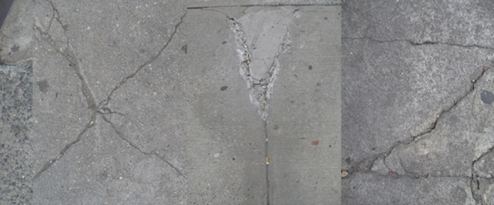

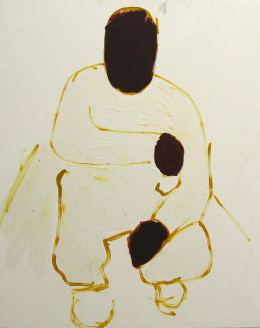
 David Nordhal,
David Nordhal, 
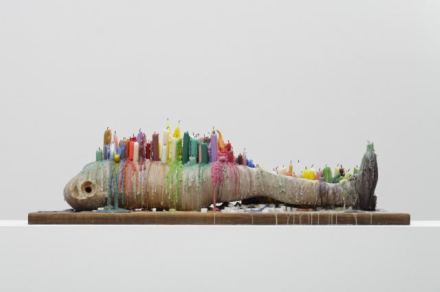
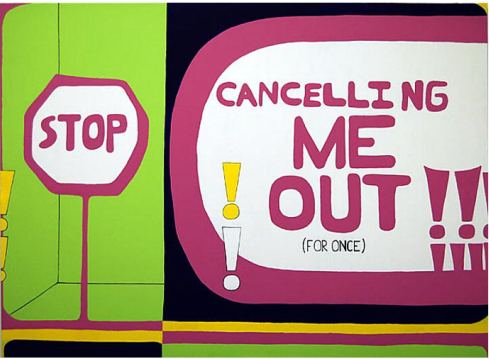
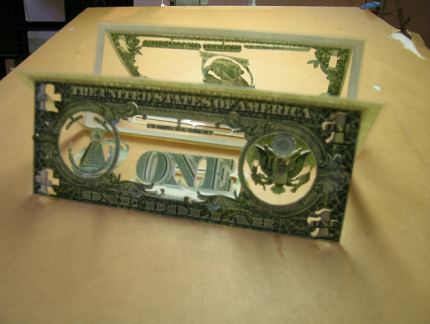
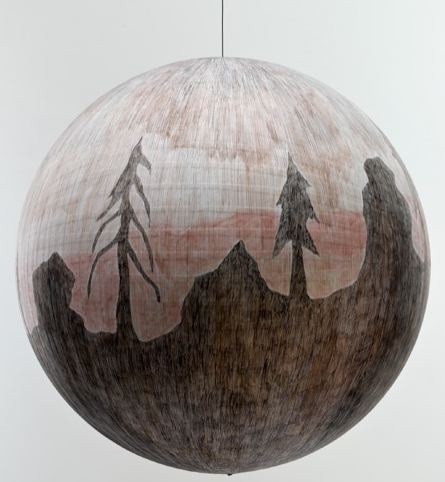
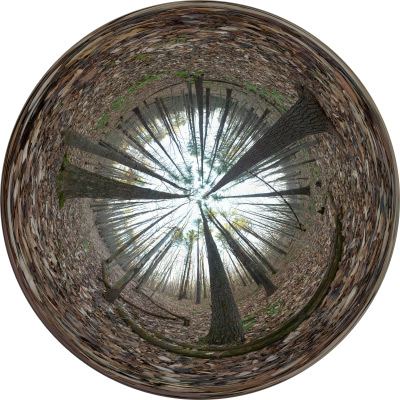
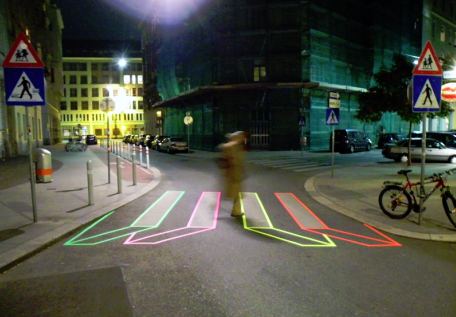
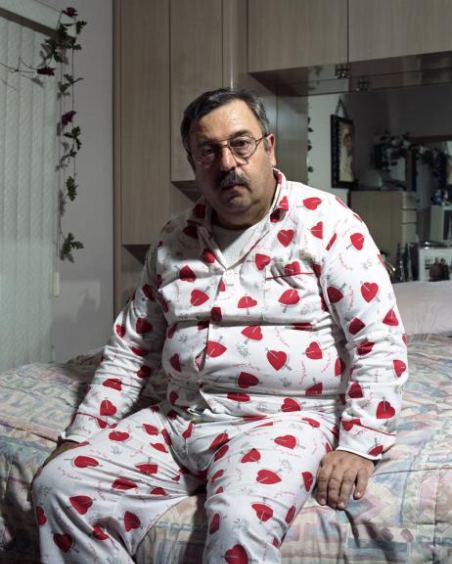
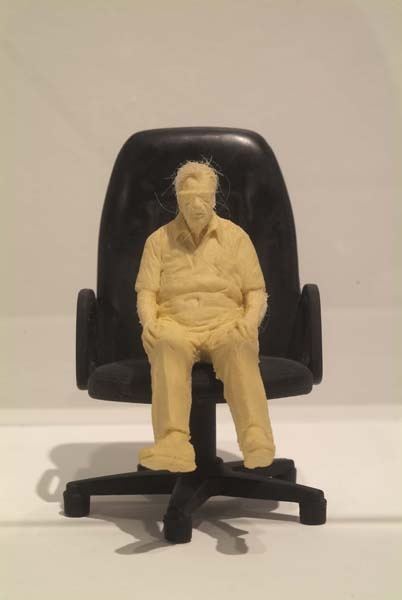
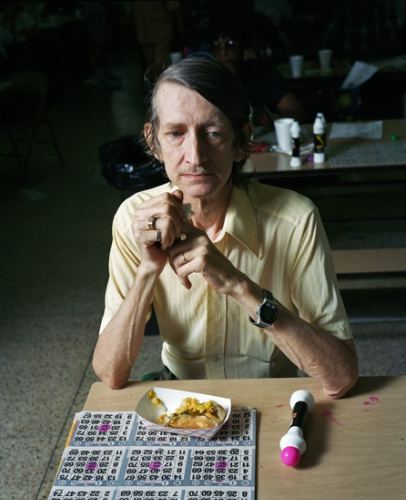
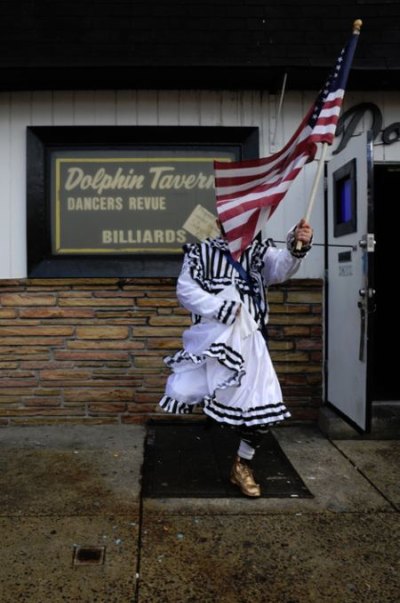

He's replying to two items in this post: